Paul van Yperen's Blog, page 287
December 10, 2017
Alla Larionova
Beautiful Russian stage and film actress Alla Larionova (1931-2000) was one of the most popular stars of the Soviet cinema of the 1950s. She was known for such films as the Fairy-tale Sadko (1952), Anna na shee (1954) and Trizhdy voskresshiy (1960).
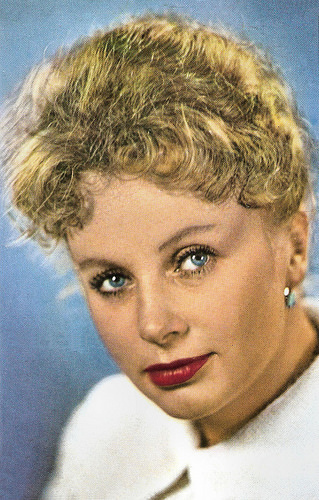
Russian postcard, no. A 09462, 1965. Photo: G. Ter-Ovanesova.
A Forbidden Beautiful World
Alla Dmitrievna Larionova was born in Moscow, USSR (now Russia) in 1931. Her father was an employee of a food store, and her mother worked as a keeper in a kindergarten. Her parents named her after the film star Alla Tarasova, and thus programmed their little daughter for the future.
After her father went to the front, Alla and her mother evacuated to Menzelinsk, where her mother worked in a hospital. Here, 9-year-old Alla Larionova appeared for the first time on stage. She read poetry to the wounded in the hospital.
When she was barely 15 years old, the young and charming Alla was discovered for the cinema. An unfamiliar woman approached her on the street, and asked if the girl wanted to act in films. Of course, Larionova wanted and appeared in a small part in the biographical drama Michurin (Aleksandr Dovzhenko, 1949), featuring Grigori Belov.
After graduation, Alla went to study as an actress at the Lunacharsky State Institute for Theatre Arts (GITIS) in Moscow. In 1948, she continued her studies at the Gerasimov Institute of Cinematography (VGIK), where she met her future husband Nikolai Rybnikov. At the GITIS, she failed miserably at her exams. Before her examiners, she saw the famous director Vasily Mikhailovich Goncharov and got a black-out.
However, during her study years, she got a star-making role, which determined her entire career in the cinema. She played Lyubava in Sadko (Aleksandr Ptushko, 1952) with Sergei Stolyarov. The Fairy-tale film was so successful that the following year the film was invited to Venice Film Festival, where it won the Silver Lion.
This success meant an international breakthrough for the Soviet cinema. In Venice, the beautiful Larionova was followed by crowds of journalists and admirers ran. Well-known producers and directors, including Charles Chaplin , offered her roles that she flatly refused. As the Russian website 24smi writes: “official representatives, officials who accompanied a group of artists abroad, were strictly forbidden to go to contacts with ‘bourgeois’ directors.” Larionova returned home from Italy in tears. She had been allowed to touch a beautiful world, to see it, but was forbidden to live in it.
Back home, she was offered the leading role in Anna na shee/The Anna Cross (Isidor Annensky, 1954), based on a short story by Anton Chekhov. The film turned Larionova into a big star of the Soviet cinema. Hundreds of people, often in bad weather, stood in queues in front of cinemas to see the film. After the actress starred as the beautiful Olivia in Dvenadtsataya noch/Twelfth Night (A. Abramov, Yan Frid, 1955), fans followed her to the studio and her apartment, looked in windows and waited for her exit. Even the minister of culture came to see the actress.
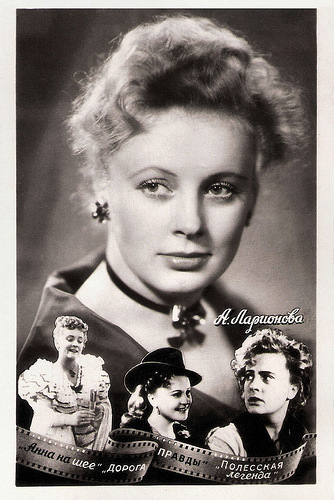
Russian postcard, no. AB13758, 1958. Photo: V. Kačna.
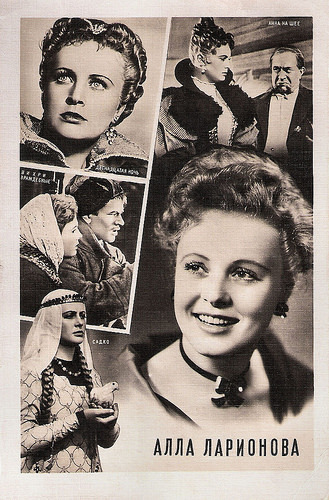
Russian multiview postcard, no. 1446, 1963. Included are scene photos from Sadko (1952), Vikhri vrazhdebnye/Hostile Whirlwinds (Mikhail Kalatozov, 1953), Anna na shee (1954), and Dvenadtsataya noch/Twelfth Night (A. Abramov, Yan Frid, 1955).
Hindered by the officials
Curiously, Alla Larionova was not offered any more leading roles and her career seemed to be hindered by officials. For example for the film Ilya Muromets/The Sword and the Dragon (Aleksandr Ptushko, 1956), Larionova was not allowed to travel to Yalta, where the shooting of the film took place.
Her few leading roles in the following years included Sudba barabanshchika/The Drummer's Fate (Viktor Eisymont, 1956), the romance Mlechnyy Put/Milky Way (Isaak Shmaruk, 1959) and Trizhdy voskresshiy/Thrice Resurrected (Leonid Gayday, 1960).
During the 1960s and 1970s, Alla Larionova never got leading roles. When the beautiful actress starred in a film it was in ‘ugly’ roles, such as in Dikiy myod/Wild Honey (Vladimir Chebotaryov, 1967), where her face was smeared with mud.
Larionova proved that she could play character roles very well. She played Natalia Dmitrievna Paskudin in the Anton Chekhov adaptation Tri sestry/The Three Sisters (Samson Samsonov, 1964), Donesova in Ko mne, Mukhtar!/Come Here, Mukhtar! (Semyon Tumanov, 1965), Elena Ivanovna in Fokusnik/The Magician (Pyotr Todorovskiy, 1967) and Ekaterina II in the family comedy Yest ideya!/There is an idea! (Vladimir Bychkov, 1977).
But the kind of roles that had made her famous, she was not offered anymore. When she turned 60, Alla Larionova was given the title People's Artist of the RSFSR in 1990, but no significant roles followed anymore. Russian Wikipedia suggests the reason was a scar in her face caused by an accident. Actor George Yumatov, in a state of intoxication, had decided to take Alla Larionova home and caused the accident at which she hit her head and cut her lip. After that, she ceased to appear in films, since the scar was too noticeable.
Larionova lived very quietly and modestly. She travelled around the country with the theatre group named after Eugene Vakhtangov. She was married to Nikolai Rybnikov from 1957 till his death in 1990. Shortly after their marriage was registered, she gave birth to her daughter Alena from actor Ivan Pereverzev. In 1961, their second daughter Arina was born. Alla Larionova died from a heart attack in 2000 in Moscow, Russia. She was buried next to her husband at the Troekurovsky cemetery. In 2004, their daughter Arina, addicted to alcohol, died.
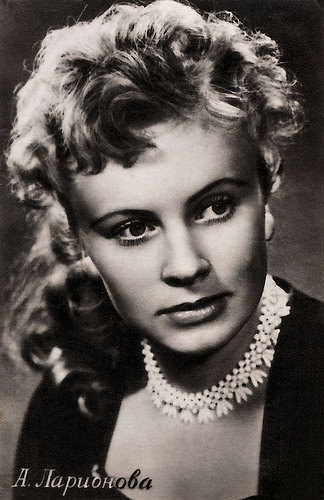
Small Russian collectors card.
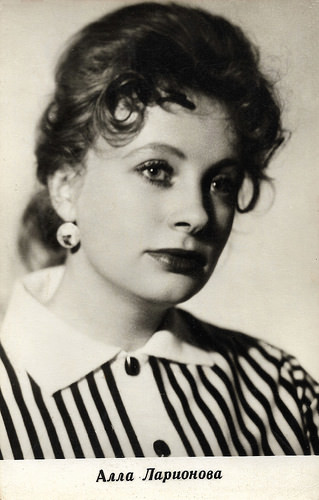
Russian postcard, no. A-06650. Photo: G. Vajlja.
Sources: 24 smi (Russian), Wikipedia (Russian) and .

Russian postcard, no. A 09462, 1965. Photo: G. Ter-Ovanesova.
A Forbidden Beautiful World
Alla Dmitrievna Larionova was born in Moscow, USSR (now Russia) in 1931. Her father was an employee of a food store, and her mother worked as a keeper in a kindergarten. Her parents named her after the film star Alla Tarasova, and thus programmed their little daughter for the future.
After her father went to the front, Alla and her mother evacuated to Menzelinsk, where her mother worked in a hospital. Here, 9-year-old Alla Larionova appeared for the first time on stage. She read poetry to the wounded in the hospital.
When she was barely 15 years old, the young and charming Alla was discovered for the cinema. An unfamiliar woman approached her on the street, and asked if the girl wanted to act in films. Of course, Larionova wanted and appeared in a small part in the biographical drama Michurin (Aleksandr Dovzhenko, 1949), featuring Grigori Belov.
After graduation, Alla went to study as an actress at the Lunacharsky State Institute for Theatre Arts (GITIS) in Moscow. In 1948, she continued her studies at the Gerasimov Institute of Cinematography (VGIK), where she met her future husband Nikolai Rybnikov. At the GITIS, she failed miserably at her exams. Before her examiners, she saw the famous director Vasily Mikhailovich Goncharov and got a black-out.
However, during her study years, she got a star-making role, which determined her entire career in the cinema. She played Lyubava in Sadko (Aleksandr Ptushko, 1952) with Sergei Stolyarov. The Fairy-tale film was so successful that the following year the film was invited to Venice Film Festival, where it won the Silver Lion.
This success meant an international breakthrough for the Soviet cinema. In Venice, the beautiful Larionova was followed by crowds of journalists and admirers ran. Well-known producers and directors, including Charles Chaplin , offered her roles that she flatly refused. As the Russian website 24smi writes: “official representatives, officials who accompanied a group of artists abroad, were strictly forbidden to go to contacts with ‘bourgeois’ directors.” Larionova returned home from Italy in tears. She had been allowed to touch a beautiful world, to see it, but was forbidden to live in it.
Back home, she was offered the leading role in Anna na shee/The Anna Cross (Isidor Annensky, 1954), based on a short story by Anton Chekhov. The film turned Larionova into a big star of the Soviet cinema. Hundreds of people, often in bad weather, stood in queues in front of cinemas to see the film. After the actress starred as the beautiful Olivia in Dvenadtsataya noch/Twelfth Night (A. Abramov, Yan Frid, 1955), fans followed her to the studio and her apartment, looked in windows and waited for her exit. Even the minister of culture came to see the actress.

Russian postcard, no. AB13758, 1958. Photo: V. Kačna.

Russian multiview postcard, no. 1446, 1963. Included are scene photos from Sadko (1952), Vikhri vrazhdebnye/Hostile Whirlwinds (Mikhail Kalatozov, 1953), Anna na shee (1954), and Dvenadtsataya noch/Twelfth Night (A. Abramov, Yan Frid, 1955).
Hindered by the officials
Curiously, Alla Larionova was not offered any more leading roles and her career seemed to be hindered by officials. For example for the film Ilya Muromets/The Sword and the Dragon (Aleksandr Ptushko, 1956), Larionova was not allowed to travel to Yalta, where the shooting of the film took place.
Her few leading roles in the following years included Sudba barabanshchika/The Drummer's Fate (Viktor Eisymont, 1956), the romance Mlechnyy Put/Milky Way (Isaak Shmaruk, 1959) and Trizhdy voskresshiy/Thrice Resurrected (Leonid Gayday, 1960).
During the 1960s and 1970s, Alla Larionova never got leading roles. When the beautiful actress starred in a film it was in ‘ugly’ roles, such as in Dikiy myod/Wild Honey (Vladimir Chebotaryov, 1967), where her face was smeared with mud.
Larionova proved that she could play character roles very well. She played Natalia Dmitrievna Paskudin in the Anton Chekhov adaptation Tri sestry/The Three Sisters (Samson Samsonov, 1964), Donesova in Ko mne, Mukhtar!/Come Here, Mukhtar! (Semyon Tumanov, 1965), Elena Ivanovna in Fokusnik/The Magician (Pyotr Todorovskiy, 1967) and Ekaterina II in the family comedy Yest ideya!/There is an idea! (Vladimir Bychkov, 1977).
But the kind of roles that had made her famous, she was not offered anymore. When she turned 60, Alla Larionova was given the title People's Artist of the RSFSR in 1990, but no significant roles followed anymore. Russian Wikipedia suggests the reason was a scar in her face caused by an accident. Actor George Yumatov, in a state of intoxication, had decided to take Alla Larionova home and caused the accident at which she hit her head and cut her lip. After that, she ceased to appear in films, since the scar was too noticeable.
Larionova lived very quietly and modestly. She travelled around the country with the theatre group named after Eugene Vakhtangov. She was married to Nikolai Rybnikov from 1957 till his death in 1990. Shortly after their marriage was registered, she gave birth to her daughter Alena from actor Ivan Pereverzev. In 1961, their second daughter Arina was born. Alla Larionova died from a heart attack in 2000 in Moscow, Russia. She was buried next to her husband at the Troekurovsky cemetery. In 2004, their daughter Arina, addicted to alcohol, died.

Small Russian collectors card.

Russian postcard, no. A-06650. Photo: G. Vajlja.
Sources: 24 smi (Russian), Wikipedia (Russian) and .
Published on December 10, 2017 22:00
December 9, 2017
Fesseln (1918)
German actress, writer and producer Hedda Vernon was the star of the Eiko Film production Fesseln/Chains (Hubert Moest, 1918). During the 1910s, she was such a popular film star in Germany that she got her own Hedda-Vernon serial.
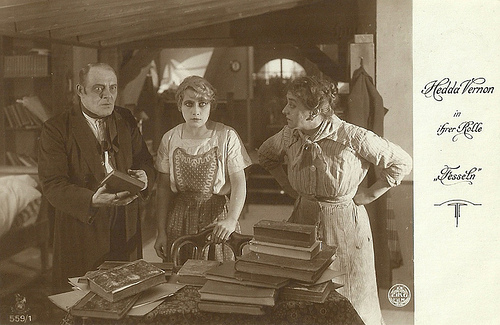
German postcard in the Film Sterne series by Rotophot, no. 559/1. Photo: Eiko-Film. Hedda Vernon and Hermann Vallentin in Fesseln (Hubert Moest, 1918).
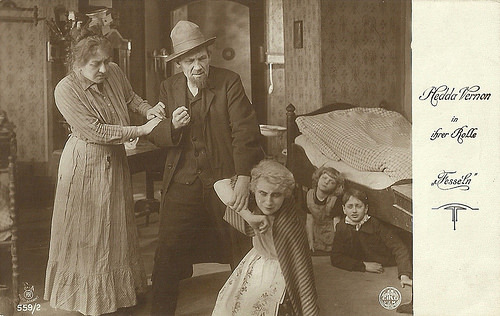
German postcard in the Film Sterne series by Rotophot, no. 559/2. Photo: Eiko-Film. Hedda Vernon in Fesseln (Hubert Moest, 1918).
A forgotten film
Little is known about this film. Fesseln/Chains (Hubert Moest, 1918) was offered to the German National Board of Censors in August 1918.
Fesseln is one of the seven silent films in which German film star Hedda Vernon (1886–1925) played the lead role in 1918. Between 1912 and 1925 she starred in more than 80 films. How and where she died is unknown.
Next to Hedda Vernon were in the cast: Emil Albes, Ewald Brückner, Lucie Friedrich, Hermann Vallentin and Erich Wilde.
The film was scripted by Richard Wilde. Director was Hubert Moest, who was Hedda Vernon 's husband from 1913 till 1920. Moest was also her regular film director at Eiko in the years 1914-1918 and afterwards at other companies, including his own company Moest-Film from 1919 on.
Rotophot produced this series of sepia postcards with scenes from the film in their Film Sterne (Film Stars) series. Number 559/5 is still missing.
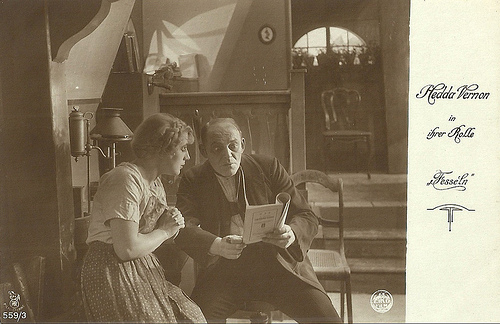
German postcard in the Film Sterne series by Rotophot, no. 559/3. Photo: Eiko-Film. Hedda Vernon and Hermann Vallentin in Fesseln (Hubert Moest, 1918).
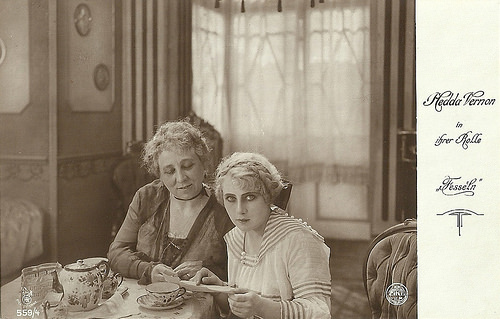
German postcard in the Film Sterne series by Rotophot, no. 559/4. Photo: Eiko-Film. Hedda Vernon in Fesseln (Hubert Moest, 1918).
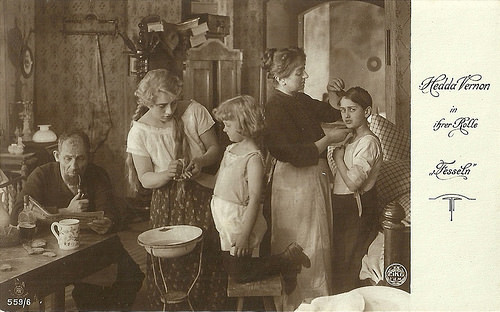
German postcard in the Film Sterne series by Rotophot, no. 559/6. Photo: Eiko-Film. Hedda Vernon in Fesseln (Hubert Moest, 1918).
Sources: Wikipedia (German) and IMDb.

German postcard in the Film Sterne series by Rotophot, no. 559/1. Photo: Eiko-Film. Hedda Vernon and Hermann Vallentin in Fesseln (Hubert Moest, 1918).

German postcard in the Film Sterne series by Rotophot, no. 559/2. Photo: Eiko-Film. Hedda Vernon in Fesseln (Hubert Moest, 1918).
A forgotten film
Little is known about this film. Fesseln/Chains (Hubert Moest, 1918) was offered to the German National Board of Censors in August 1918.
Fesseln is one of the seven silent films in which German film star Hedda Vernon (1886–1925) played the lead role in 1918. Between 1912 and 1925 she starred in more than 80 films. How and where she died is unknown.
Next to Hedda Vernon were in the cast: Emil Albes, Ewald Brückner, Lucie Friedrich, Hermann Vallentin and Erich Wilde.
The film was scripted by Richard Wilde. Director was Hubert Moest, who was Hedda Vernon 's husband from 1913 till 1920. Moest was also her regular film director at Eiko in the years 1914-1918 and afterwards at other companies, including his own company Moest-Film from 1919 on.
Rotophot produced this series of sepia postcards with scenes from the film in their Film Sterne (Film Stars) series. Number 559/5 is still missing.

German postcard in the Film Sterne series by Rotophot, no. 559/3. Photo: Eiko-Film. Hedda Vernon and Hermann Vallentin in Fesseln (Hubert Moest, 1918).

German postcard in the Film Sterne series by Rotophot, no. 559/4. Photo: Eiko-Film. Hedda Vernon in Fesseln (Hubert Moest, 1918).

German postcard in the Film Sterne series by Rotophot, no. 559/6. Photo: Eiko-Film. Hedda Vernon in Fesseln (Hubert Moest, 1918).
Sources: Wikipedia (German) and IMDb.
Published on December 09, 2017 22:00
December 8, 2017
Ulli Lommel (1944-2017)
German actor and director Ulli Lommel (1944-2017) died of cardiac arrest on 2 December. He was one of the most consistently creative filmmakers to come from the New German Cinema movement. Lommel was best known for his frequent collaborations with Andy Warhol and Rainer Werner Fassbinder. The creative partnership with Fassbinder lasted 10 years and produced over 20 films.
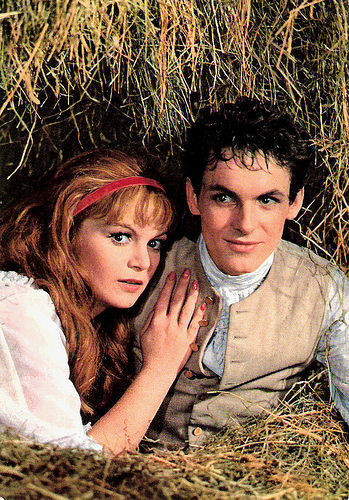
German postcard by Krüger, no. 902/303. Photo: Bernard of Hollywood / CCC-Zugsmith Co-produktion. Publicity still for Fanny Hill (Russ Meyer, 1964) with Leticia Román .
Fassbinder
Ulrich Manfred Lommel was born in 1944 in Zielenzig, Brandenburg, Germany (now Sulecin, Lubuskie, Poland). Ulli was the son of German comedian and radio personality Ludwig Manfred Lommel, and actress Karla Von Cleef. He was born a few weeks before the arrival of the Red Army, and Lommel's family fled the city, wrapping baby Ulli in a roll of carpet.
Ulli began his career in show business as a child. In 1948, at the age of four, he was put on stage by his father, who was often referred to as the ' Charles Chaplin of Germany' . While living in Bad Nauheim as a teenager, Lommel performed with Elvis Presley. Lommel decided that he wanted to pursue an acting career, but his father did not approve. So 16-years-old Ulli ran away from home.
During his career, he acted in over 28 plays, among them William Shakespeare's Hamlet - in which he played the lead. In 1962, he made his film debut opposite Maria Schell and Paul Hubschmid in Ich bin auch nur eine Frau/I, Too, Am Only a Woman (Alfred Weidenmann, 1962).
He also appeared in Fanny Hill (Russ Meyer, 1964) with Leticia Román and Miriam Hopkins, and Maigret und sein grösster Fall/Enter Inspector Maigret (Alfred Weidenmann, 1966) featuring Heinz Rühmann . In total he played in 22 TV films and 18 films.
In 1968, he joined Rainer Werner Fassbinder and the Anti-Theater, an inspired theater collective that launched the careers of several prominent German actors including Kurt Raab, Hanna Schygulla and Margit Carstensen. As Fassbinder moved from theatre to films in the 1970s, rapidly becoming one of the leading voices of the German New Wave, Lommel became one of his closest collaborators.
He spent 10 years working with Rainer Werner Fassbinder , who was legendary for his prodigious output, directing 41 films in 13 years. Lommel not only acted in 16 Fassbinder productions but also served as producer, assistant director and production designer, on such films as Fassbinder's directorial debut Liebe ist kälter als der Tod (1969) in which he also starred opposite Hanna Schygulla , Fontane Effi Briest (1974), the surrealist Western Whity (1975), Satansbraten (1976), and Chinesisches Roulette (1976).
Lommel also appeared in films by other directors such as Deine Zärtlichkeiten/Your caresses (Peter Schamoni, Herbert Vesely, 1969) with Doris Kunstmann, Anglia (Werner Schroeter, 1970), Harlis (Robert van Ackeren, 1972), and Schatten der Engel/Shadow of Angels (Daniel Schmid, 1976).
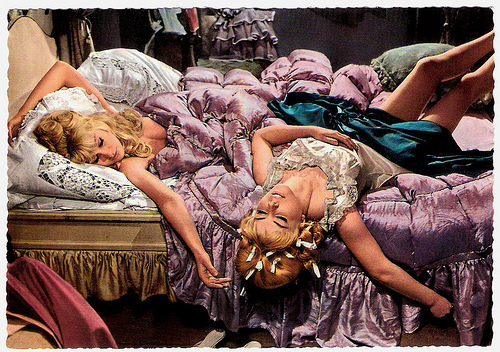
German postcard by Krüger, no. 902/358. Photo: Bernard of Hollywood. Publicity still for Fanny Hill (1964) with Renate Hütte and Britt Lindberg.
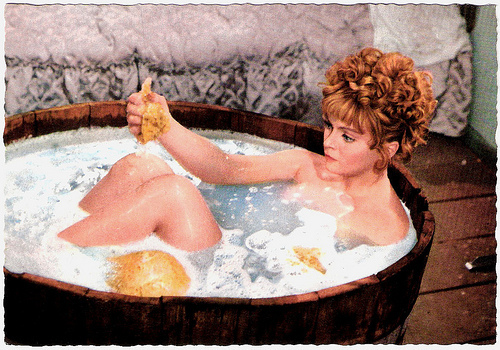
German postcard by Krüger, no. 902/302. Photo: Bernard of Hollywood / CCC-Zugsmith Co-produktion. Publicity still for Fanny Hill (Russ Meyer, 1964) with Leticia Román .
Warhol
In 1971 Ulli Lommel directed his first film, Haytabo (1971), starring Eddie Constantine . His second feature film as a director, Die Zärtlichkeit der Wölfe/Tenderness of the Wolves (1973) with Kurt Raab as a gay serial killer, became a cult hit. It was based on the story of murderer Fritz Haarmann, who was also the inspiration for Fritz Lang's M (1931).
It brought Lommel in 1977 to New York, where he began working with Andy Warhol at The Factory. The Warhol / Lommel years spawned several features, including Cocaine Cowboys (1979) and Blank Generation (1980) with Carole Bouquet, both of which were directed by Lommel and feature Warhol in an acting role.
In 1980 Lommel moved to Hollywood and made independently The Boogey Man (1980), starring John Carradine, which became an overnight sensation and grossed over $35 million worldwide.
Many of Lommel's post-Boogeyman films, such as Olivia (1983), BrainWaves (1982) starring Tony Curtis, The Devonsville Terror (1983) starring Donald Pleasence, also starred his wife at the time, Suzanna Love.
Since Rainer Werner Fassbinder 's death in 1982, Lommel has also been travelling the world and participating in numerous retrospectives dedicated to his Fassbinder years, among them the Museum of Modern Art in N.Y., Harvard, the Louvre, London and Beijing.
In 2004 Lommel started his own repertory group in Venice, California, where he and his collaborators have made 16 genre films. In 2008 Lommel teamed up with David Carradine, who starred in Lommel's drama Absolute Evil (2009).
In 2013 Lommel went for nine months to Brazil, where he wrote a book and also made two films. The first was the bio-epic documentary Mondo Americana (2015) and the second a film about Campo Bahia, the official camp for the German National Soccer Team. His autobiography, Tenderness of the Wolves, was released in 2015.
Ulli Lommel married and divorced three actresses, Katrin Schaake, Suzanna Love, and Cookie Lommel.
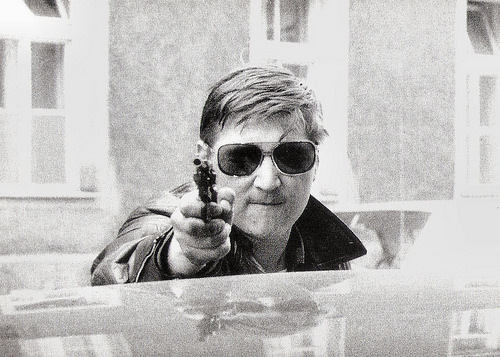
German postcard by Hias Schasko Postkarten, München. Photo: Filmverlag der Autoren. Publicity still for Liebe ist kälter als der Tod/Love Is Colder Than Death (Rainer Werner Fassbinder, 1969) with Fassbinder himself.
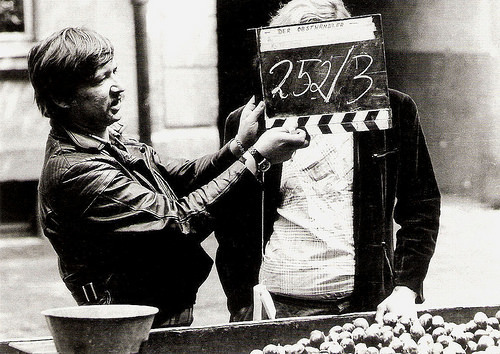
German postcard by Verlag Hias Schaschko, München (Munich), no. 209. Photo: Rainer Werner Fassbinder during the shooting of his film Händler der vier Jahreszeiten/The Merchant of Four Seasons (1971), then still called Der Obsthändler/The Grocer.
Trailer Die Zärtlichkeit der Wölfe (1973). Source: Alles kino (YouTube).
Trailer The Boogey Man (1980). Source: Silky Stalin (YouTube).
Sources: (IMDb), Les Gens du Cinéma, Wikipedia and .

German postcard by Krüger, no. 902/303. Photo: Bernard of Hollywood / CCC-Zugsmith Co-produktion. Publicity still for Fanny Hill (Russ Meyer, 1964) with Leticia Román .
Fassbinder
Ulrich Manfred Lommel was born in 1944 in Zielenzig, Brandenburg, Germany (now Sulecin, Lubuskie, Poland). Ulli was the son of German comedian and radio personality Ludwig Manfred Lommel, and actress Karla Von Cleef. He was born a few weeks before the arrival of the Red Army, and Lommel's family fled the city, wrapping baby Ulli in a roll of carpet.
Ulli began his career in show business as a child. In 1948, at the age of four, he was put on stage by his father, who was often referred to as the ' Charles Chaplin of Germany' . While living in Bad Nauheim as a teenager, Lommel performed with Elvis Presley. Lommel decided that he wanted to pursue an acting career, but his father did not approve. So 16-years-old Ulli ran away from home.
During his career, he acted in over 28 plays, among them William Shakespeare's Hamlet - in which he played the lead. In 1962, he made his film debut opposite Maria Schell and Paul Hubschmid in Ich bin auch nur eine Frau/I, Too, Am Only a Woman (Alfred Weidenmann, 1962).
He also appeared in Fanny Hill (Russ Meyer, 1964) with Leticia Román and Miriam Hopkins, and Maigret und sein grösster Fall/Enter Inspector Maigret (Alfred Weidenmann, 1966) featuring Heinz Rühmann . In total he played in 22 TV films and 18 films.
In 1968, he joined Rainer Werner Fassbinder and the Anti-Theater, an inspired theater collective that launched the careers of several prominent German actors including Kurt Raab, Hanna Schygulla and Margit Carstensen. As Fassbinder moved from theatre to films in the 1970s, rapidly becoming one of the leading voices of the German New Wave, Lommel became one of his closest collaborators.
He spent 10 years working with Rainer Werner Fassbinder , who was legendary for his prodigious output, directing 41 films in 13 years. Lommel not only acted in 16 Fassbinder productions but also served as producer, assistant director and production designer, on such films as Fassbinder's directorial debut Liebe ist kälter als der Tod (1969) in which he also starred opposite Hanna Schygulla , Fontane Effi Briest (1974), the surrealist Western Whity (1975), Satansbraten (1976), and Chinesisches Roulette (1976).
Lommel also appeared in films by other directors such as Deine Zärtlichkeiten/Your caresses (Peter Schamoni, Herbert Vesely, 1969) with Doris Kunstmann, Anglia (Werner Schroeter, 1970), Harlis (Robert van Ackeren, 1972), and Schatten der Engel/Shadow of Angels (Daniel Schmid, 1976).

German postcard by Krüger, no. 902/358. Photo: Bernard of Hollywood. Publicity still for Fanny Hill (1964) with Renate Hütte and Britt Lindberg.

German postcard by Krüger, no. 902/302. Photo: Bernard of Hollywood / CCC-Zugsmith Co-produktion. Publicity still for Fanny Hill (Russ Meyer, 1964) with Leticia Román .
Warhol
In 1971 Ulli Lommel directed his first film, Haytabo (1971), starring Eddie Constantine . His second feature film as a director, Die Zärtlichkeit der Wölfe/Tenderness of the Wolves (1973) with Kurt Raab as a gay serial killer, became a cult hit. It was based on the story of murderer Fritz Haarmann, who was also the inspiration for Fritz Lang's M (1931).
It brought Lommel in 1977 to New York, where he began working with Andy Warhol at The Factory. The Warhol / Lommel years spawned several features, including Cocaine Cowboys (1979) and Blank Generation (1980) with Carole Bouquet, both of which were directed by Lommel and feature Warhol in an acting role.
In 1980 Lommel moved to Hollywood and made independently The Boogey Man (1980), starring John Carradine, which became an overnight sensation and grossed over $35 million worldwide.
Many of Lommel's post-Boogeyman films, such as Olivia (1983), BrainWaves (1982) starring Tony Curtis, The Devonsville Terror (1983) starring Donald Pleasence, also starred his wife at the time, Suzanna Love.
Since Rainer Werner Fassbinder 's death in 1982, Lommel has also been travelling the world and participating in numerous retrospectives dedicated to his Fassbinder years, among them the Museum of Modern Art in N.Y., Harvard, the Louvre, London and Beijing.
In 2004 Lommel started his own repertory group in Venice, California, where he and his collaborators have made 16 genre films. In 2008 Lommel teamed up with David Carradine, who starred in Lommel's drama Absolute Evil (2009).
In 2013 Lommel went for nine months to Brazil, where he wrote a book and also made two films. The first was the bio-epic documentary Mondo Americana (2015) and the second a film about Campo Bahia, the official camp for the German National Soccer Team. His autobiography, Tenderness of the Wolves, was released in 2015.
Ulli Lommel married and divorced three actresses, Katrin Schaake, Suzanna Love, and Cookie Lommel.

German postcard by Hias Schasko Postkarten, München. Photo: Filmverlag der Autoren. Publicity still for Liebe ist kälter als der Tod/Love Is Colder Than Death (Rainer Werner Fassbinder, 1969) with Fassbinder himself.

German postcard by Verlag Hias Schaschko, München (Munich), no. 209. Photo: Rainer Werner Fassbinder during the shooting of his film Händler der vier Jahreszeiten/The Merchant of Four Seasons (1971), then still called Der Obsthändler/The Grocer.
Trailer Die Zärtlichkeit der Wölfe (1973). Source: Alles kino (YouTube).
Trailer The Boogey Man (1980). Source: Silky Stalin (YouTube).
Sources: (IMDb), Les Gens du Cinéma, Wikipedia and .
Published on December 08, 2017 22:00
December 7, 2017
De Reszke Cigarettes
We continue our Saturday posts on British film postcard series with De Reszke postcards. De Reske was a, now forgotten, British cigarette brand. It was named after Jean de Reszke (1850-1925), a famous Polish opera star of the late 19th century, and advertised as 'the Aristocrat of Cigarettes'. Ads suggested the cigarettes were 'mild and harmless' so that they would not damage De Reszke's voice. The brand was originally produced by J. Millhoff, a Russian living in London. In 1927, Millhoff sold out to Godrey Phillips, an international company which was a fellow competitor. In the early 1930s, Godfrey Phillips Associated brands published this series of hand-coloured film star postcards. The postcards appeared in larger packings of De Reszke Cigarettes and other brands of Godfrey Phillips. Smaller pictures of film stars appeared in the other packings.
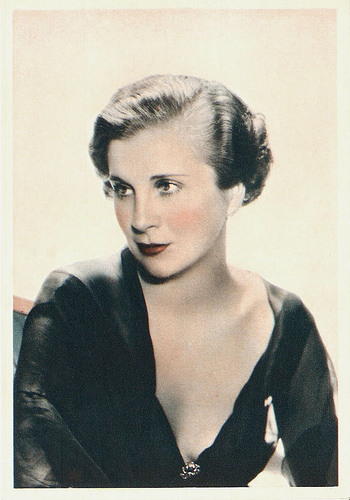
Diana Wynyard . British postcard by De Reszke Cigarettes, no. 3.
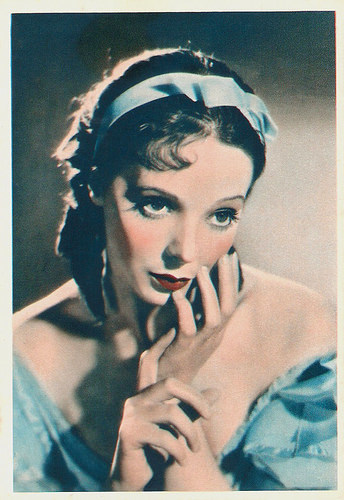
Jessie Matthews . British collectors card by De Reszke Cigarettes, no. 9. Photo: Gaumont-British.
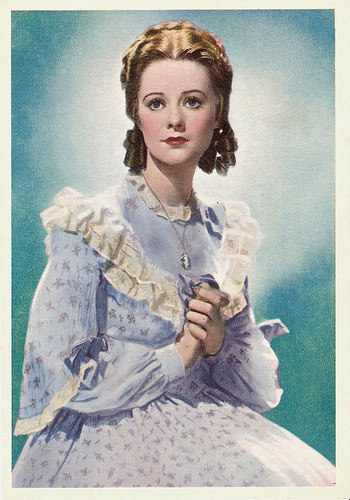
Heather Angel . British postcard by De Reszke Cigarettes, no. 12. Photo: possibly a publicity still for The Hound of the Baskervilles (Gareth Gundrey, 1931).
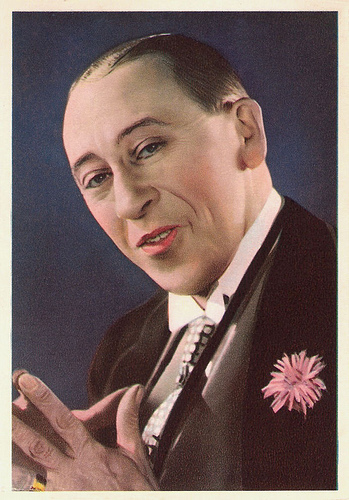
Gordon Harker . British postcard by De Reszke Cigarettes, no. 14. Photo: Gaumont.
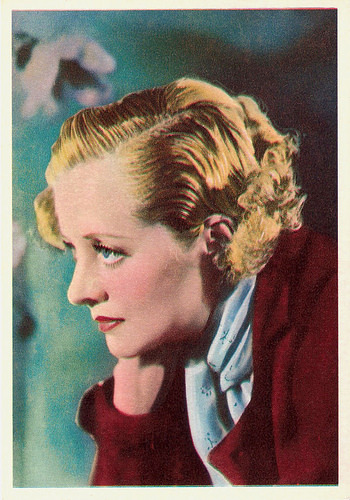
Evelyn Laye . British postcard by De Reszke Cigarettes, no. 21. Photo: Gaumont-British.
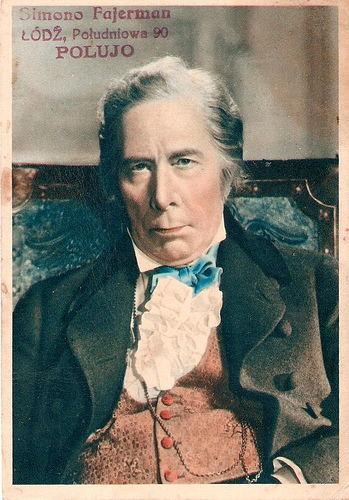
George Arliss . British postcard with Polish imprint by De Reszke Cigarettes, no. 22. Photo: publicity still for The House of Rothschild (Alfred L. Werker, 1934).
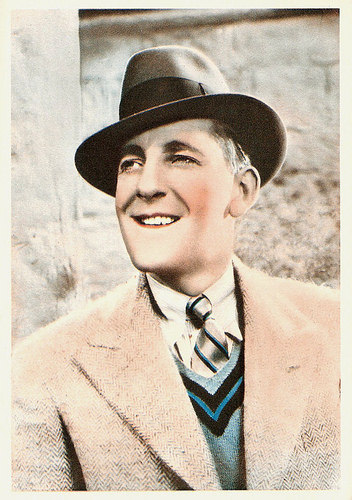
Jack Hulbert . British postcard by De Reszke Cigarettes, no. 30. Photo: Gaumont-British.
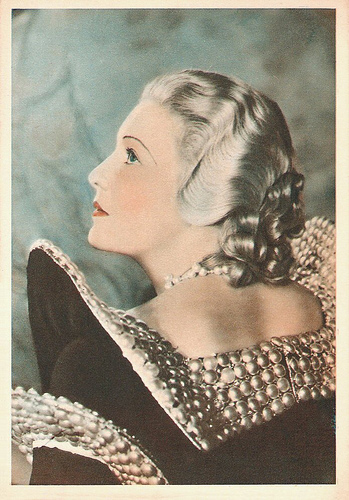
Madeleine Carroll . British postcard by De Reszke Cigarettes, no. 32. Photo: Gaumont-British. Publicity still for The Dictator/Loves of a Dictator (Victor Saville, 1935).
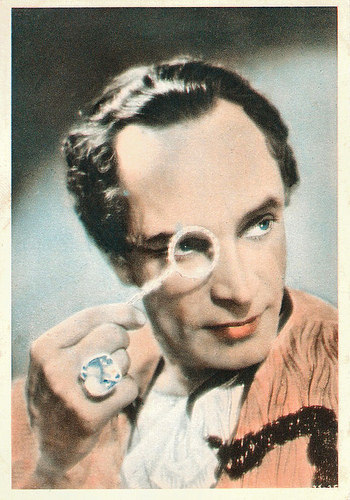
Conrad Veidt . British postcard by De Reszke Cigarettes, no. 33. Photo: Gaumont-British. Publicity still for Jew Süss (Lothar Mendes, 1934).
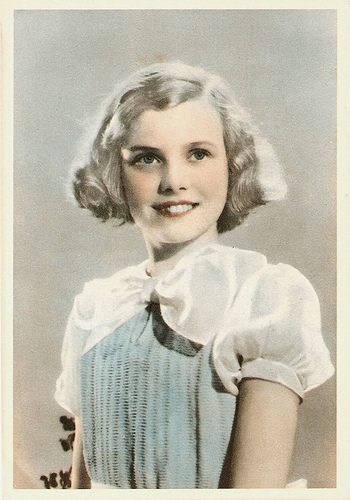
Nova Pilbeam . British postcard by De Reszke Cigarettes, no. 39. Photo: Gaumont-British.
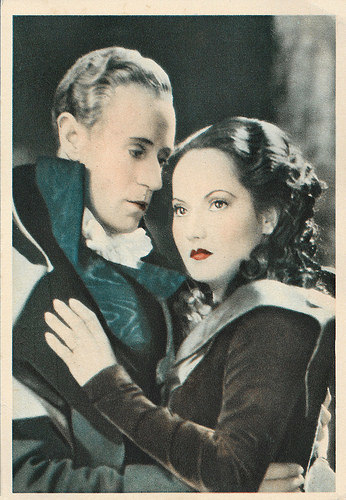
Leslie Howard and Merle Oberon . British postcard by De Reszke Cigarettes, no. 44. Photo: London Films. Publicity still for The Scarlet Pimpernel (Harold Young, 1934).
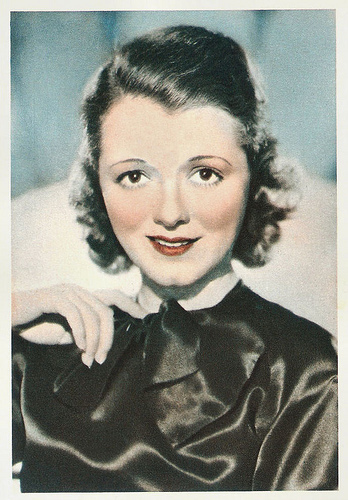
Janet Gaynor . British postcard by De Reszke Cigarettes, no. 45.
Sources:
It is Postcard Friendship Friday, hosted by Beth at the The Best Hearts are Crunchy. You can visit her by clicking on the button below.


Diana Wynyard . British postcard by De Reszke Cigarettes, no. 3.

Jessie Matthews . British collectors card by De Reszke Cigarettes, no. 9. Photo: Gaumont-British.

Heather Angel . British postcard by De Reszke Cigarettes, no. 12. Photo: possibly a publicity still for The Hound of the Baskervilles (Gareth Gundrey, 1931).

Gordon Harker . British postcard by De Reszke Cigarettes, no. 14. Photo: Gaumont.

Evelyn Laye . British postcard by De Reszke Cigarettes, no. 21. Photo: Gaumont-British.

George Arliss . British postcard with Polish imprint by De Reszke Cigarettes, no. 22. Photo: publicity still for The House of Rothschild (Alfred L. Werker, 1934).

Jack Hulbert . British postcard by De Reszke Cigarettes, no. 30. Photo: Gaumont-British.

Madeleine Carroll . British postcard by De Reszke Cigarettes, no. 32. Photo: Gaumont-British. Publicity still for The Dictator/Loves of a Dictator (Victor Saville, 1935).

Conrad Veidt . British postcard by De Reszke Cigarettes, no. 33. Photo: Gaumont-British. Publicity still for Jew Süss (Lothar Mendes, 1934).

Nova Pilbeam . British postcard by De Reszke Cigarettes, no. 39. Photo: Gaumont-British.

Leslie Howard and Merle Oberon . British postcard by De Reszke Cigarettes, no. 44. Photo: London Films. Publicity still for The Scarlet Pimpernel (Harold Young, 1934).

Janet Gaynor . British postcard by De Reszke Cigarettes, no. 45.
Sources:
It is Postcard Friendship Friday, hosted by Beth at the The Best Hearts are Crunchy. You can visit her by clicking on the button below.

Published on December 07, 2017 22:00
December 6, 2017
Johnny Hallyday (1943-2017)
The father of French Rock and Roll is dead. Flamboyant singer and actor Johnny Hallyday (1943-2017) passed away yesterday, 6 December. He was a European teen idol in the 1960s with record-breaking crowds and mass hysteria, but he never became popular in the English-speaking market. In later years he concentrated on being an actor and appeared in more than 35 films. Johnny Hallyday was 74.
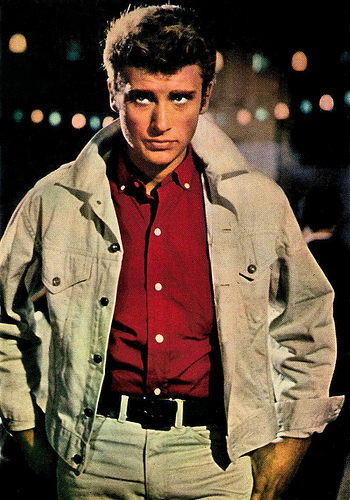
Italian postcard by Rotalfoto, Milano, no. 4208 04-025 U.
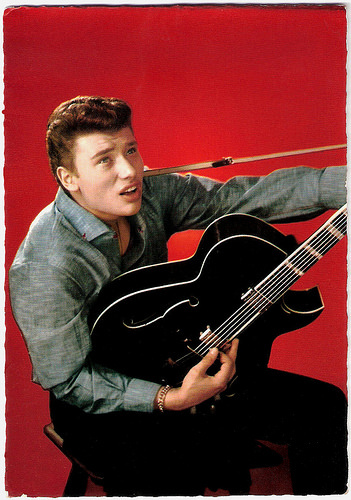
French postcard by E.D.U.G., Paris, no. 170. Photo: Sam Lévin.
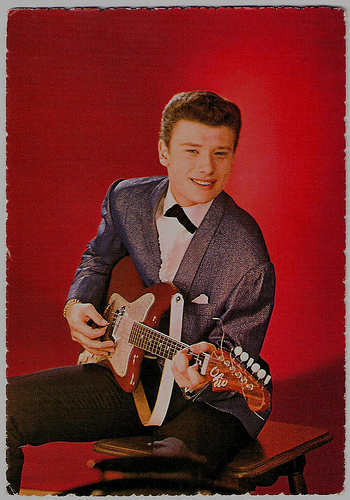
French postcard, no. 171. Photo: Sam Lévin.
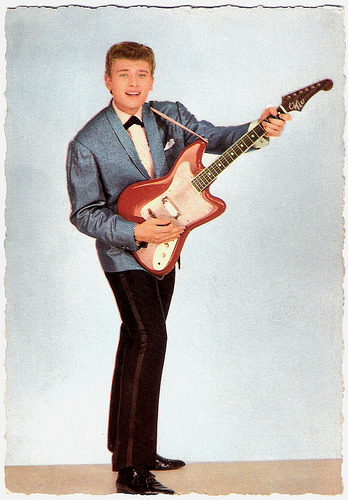
French postcard by E.D.U.G., Paris, no. 189. Photo: Sam Lévin.
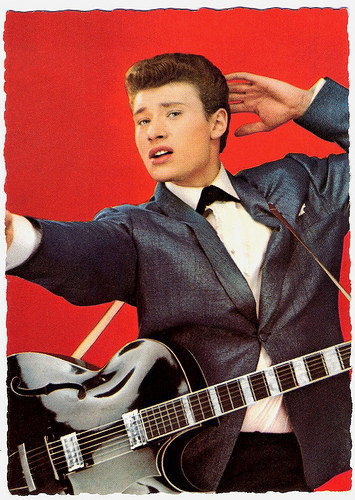
French postcard by E.D.U.G., Paris, no. 215. Photo: Sam Lévin.
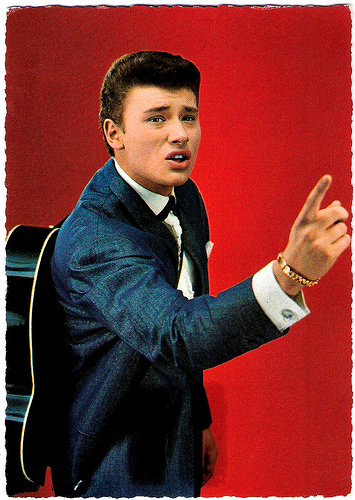
French postcard by E.D.U.G., no. 266. Photo: Sam Lévin.
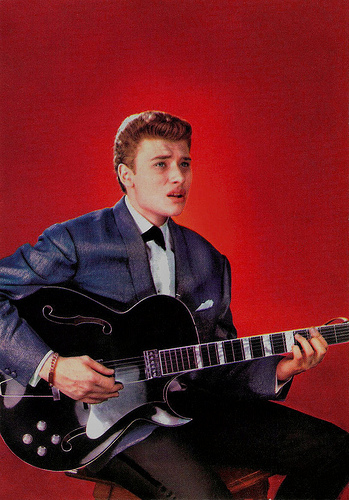
French postcard by Editions P.I., Paris, no. 1063. Photo: Sam Lévin.
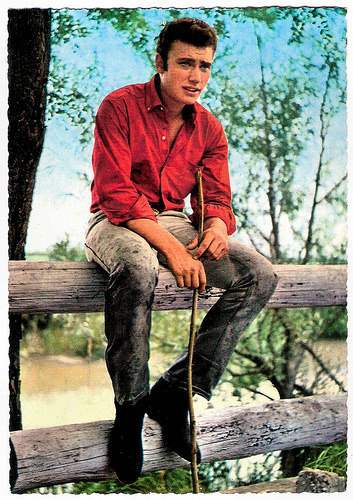
West-German postcard by Krüger, no. 902/225. Photo: Gérard Decaux.
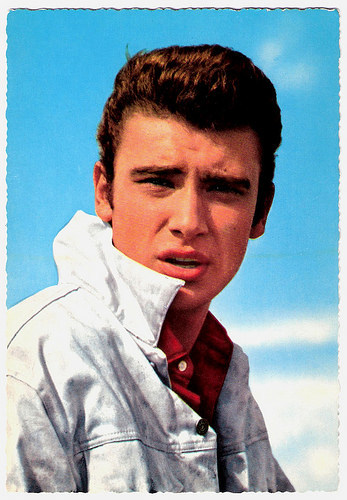
West-German postcard by Krüger, no. 902/226. Photo: Gérard Decaux.
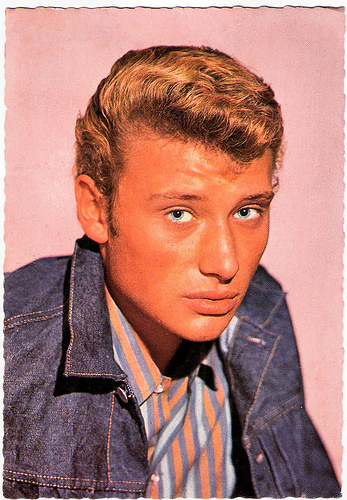
French postcard by E.D.U.G., Paris, no. 431. Photo: LYNX / Philips.
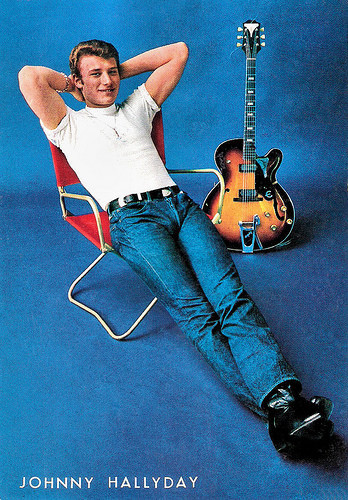
French postcard by Publistar, Marseille, no. 750. Photo: Herman Leonard / Philips.
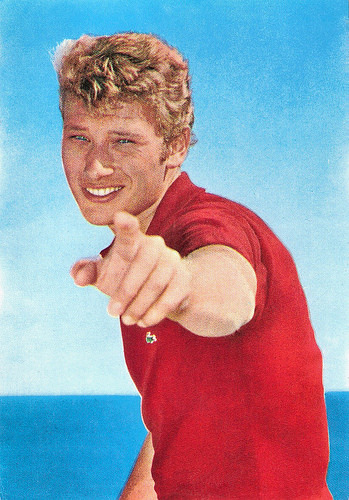
French postcard by Publistar, Marseille, no. 773. Photo: Aubert / Philips.
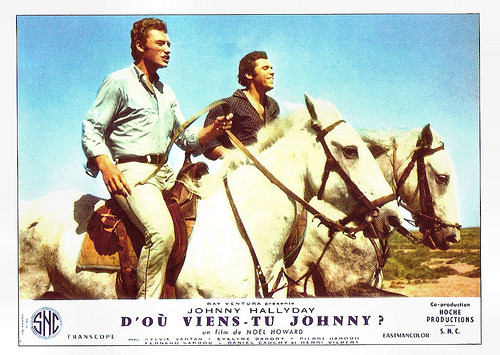
French postcard by Encyclopédie du Cinéma, no. EDC 550 Vis. 1. Photo: publicity still for D'où viens-tu... Johnny?/Where Are You From, Johnny? (Noël Howard, 1963).
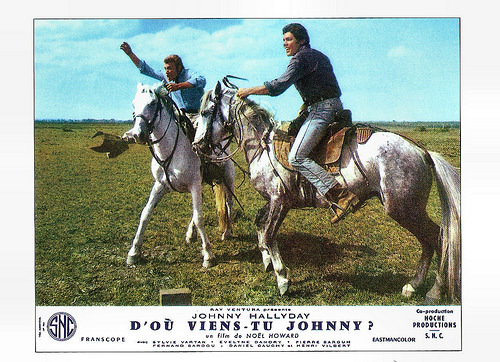
French postcard by Encyclopédie du Cinéma, no. EDC 550 Vis. 4. Photo: publicity still for D'où viens-tu... Johnny?/Where Are You From, Johnny? (Noël Howard, 1963).
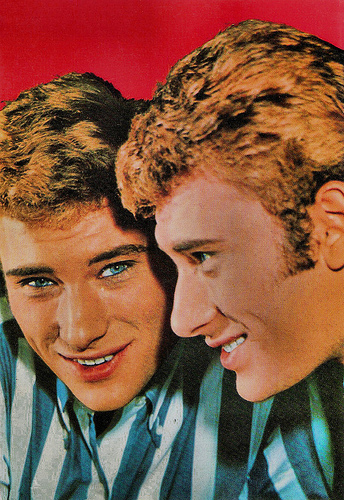
Spanish postcard by Postal Oscarcolor, no. 210, 1964.
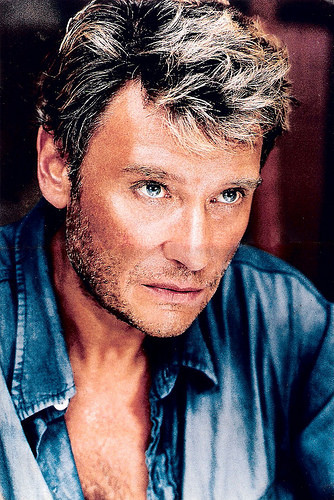
French photo.
Read also our biography of Johnny Hallyday with more postcards .

Italian postcard by Rotalfoto, Milano, no. 4208 04-025 U.

French postcard by E.D.U.G., Paris, no. 170. Photo: Sam Lévin.

French postcard, no. 171. Photo: Sam Lévin.

French postcard by E.D.U.G., Paris, no. 189. Photo: Sam Lévin.

French postcard by E.D.U.G., Paris, no. 215. Photo: Sam Lévin.

French postcard by E.D.U.G., no. 266. Photo: Sam Lévin.

French postcard by Editions P.I., Paris, no. 1063. Photo: Sam Lévin.

West-German postcard by Krüger, no. 902/225. Photo: Gérard Decaux.

West-German postcard by Krüger, no. 902/226. Photo: Gérard Decaux.

French postcard by E.D.U.G., Paris, no. 431. Photo: LYNX / Philips.

French postcard by Publistar, Marseille, no. 750. Photo: Herman Leonard / Philips.

French postcard by Publistar, Marseille, no. 773. Photo: Aubert / Philips.

French postcard by Encyclopédie du Cinéma, no. EDC 550 Vis. 1. Photo: publicity still for D'où viens-tu... Johnny?/Where Are You From, Johnny? (Noël Howard, 1963).

French postcard by Encyclopédie du Cinéma, no. EDC 550 Vis. 4. Photo: publicity still for D'où viens-tu... Johnny?/Where Are You From, Johnny? (Noël Howard, 1963).

Spanish postcard by Postal Oscarcolor, no. 210, 1964.

French photo.
Read also our biography of Johnny Hallyday with more postcards .
Published on December 06, 2017 22:00
December 5, 2017
Monika Gabriel
German actress Monika Gabriel (1943-2007) was known for her many DEFA films and her appearances in TV series in East-Germany. From 1971, she worked in West-Germany, mainly for television.
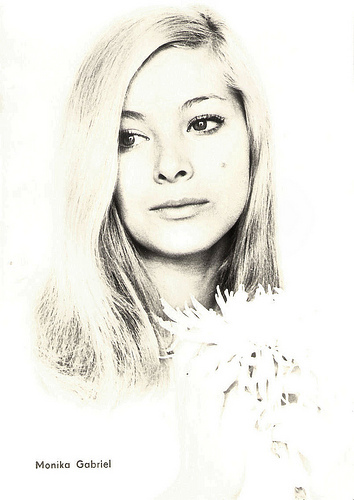
East-German postcard by VEB Progress Film-Vertrieb, Berlin, no. 3320, 1968. Photo: Schwarz.
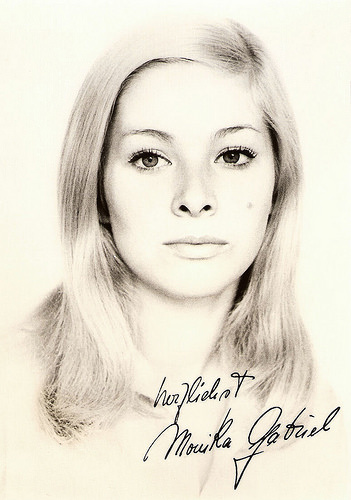
East-German postcard by VEB Progress Film-Vertrieb, Berlin, no. 3324, 1969. Photo: Schwarz.
The Emperor’s New Clothes
Monika Gabriel was born in Eichenbriick, near Posen (now Poznań) in Germany (now Poland) in 1943. From 1949 on, she grew up in Falkensee, a city near the Baltic Sea, where she began to take ballet lessons at the age of eleven.
From 1957 to 1961 she trained as a professional dancer at the Academy for Artistic Dance and the Staatliche Ballettschule Berlin. From 1962 on, she also played small parts in stage productions at the Berlin Metropol Theater, where she was later transferred to major roles in musical productions like Cole Porter’s Küß mich, Kätchen! (Kiss Me Kate).
However, she was known by the East-German public for her roles in many film and television productions. In 1962, she made her film debut at the DEFA as a page in the fairy tale film Das Kleid/The Robe (Konrad Petzold, 1962) based on Hans Christian Andersen’s fairy tale The Emperor’s New Clothes. Sadly the film was banned by the GDR government as its planned release coincided with the building of the Berlin Wall. Officials saw the film as too critical of the state.
In the next years, she played in the popular Stacheltier stunt film short s Stacheltier: Engel, Sünden und Verkehr/Porcupine: Angels, Sins and Traffic (Horst Seemann, 1963) and Stacheltier: Liebe braucht keine PS/Porcupine: Love Doesn’t Require HP (Horst Seemann, 1964).
Gabriel’s first major role was in Gerhard Klein and Wolfgang Kohlhaase’s Berlin um die Ecke/Berlin Around the Corner (1965), the fourth film in their Berlin Film series. At the East German Cinema Blog , Jim Morton writes: “Unfortunately, this was the same year that the 11th Plenum occurred. By the time the film was finished in 1966, the 11th Plenum had started their ‘Kahlschlag’ (literally ‘clear cutting’), and the film was promptly rejected and shelved. The officials called it ‘dishonest,’ which is an odd thing to say considering it’s one of the most honest films to ever come out of East Germany. They also called it ‘anti-socialist’—an even more absurd claim since the motivation of the main character is his desire to see equity achieved. (…) Like most of the films banned during the 11th Plenum, Berlin Around the Corner didn’t get an official release until after the wall came down, although it did receive a limited screening in 1987. It officially premiered in 1990 to positive reviews. “
Next Monika Gabriel appeared in Ein Lord am Alexanderplatz/A Lord at Alexanderplatz (1967), Wir lassen uns scheiden/We’re Getting Divorced (Ingrid Reschke, 1967) about the impact of divorce on children, and Jungfer, Sie gefällt mir/Maiden, You Please Me (Günter Reisch,1969), with a script by Jurek Becker based on Heinrich von Kleist’s Der zerbrochene Krug. Monika Gabriel fell in love with her co-star in the film, the West German actor Wolfgang Kieling, who had recently moved to the GDR. In the following year they married.
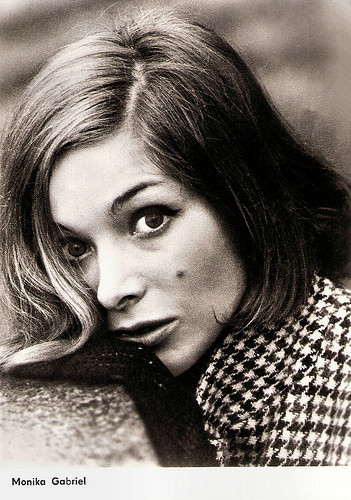
East-German postcard by VEB Progress Film-Vertrieb, Berlin, no. 3047, 1968. Photo: Balinski.
Exit Permit
In 1971, when Wolfgang Kieling returned to the Federal Republic of Germany, Monika Gabriel also received an exit permit. Her final GDR film was Anflug Alpha 1/Approach Alpha I (János Veiczi, 1971) with Alfred Müller and Polish-born actor Stefan Lisewski .
From then on, Monika Gabriel mainly played in television productions such as episodes of Krimi series like Dem Täter auf der Spur/The Perpetrator on the Trail (Jürgen Roland, 1972), Tatort/Crime Scene (1975) and Derrick (1977).
She also appeared in the TV film Die Rakete/The Rocket (Dieter Wedel, 1975) and she had guest spots in such series as St. Pauli-Landungsbrücken/St. Pauli-Jetties (1979), Auf Achse/On Axis (1981), Der König und sein Narr/The King and His Fool (Frank Beyer, 1981) with Wolfgang Kieling and Götz George , Kreisbrandmeister Felix Martin/ Fire Chief Felix Martin (Harald Philipp, 1982) also with Kieling, and Eine Klasse für sich/A Class of its Own (Frank Strecker, 1984).
In 1985, she played her last TV role in an episode of the TV series Berliner Weiße mit Schuß/Berliner Weisse with a Shot (Wilfried Dotzel, 1985) with Günther Pfitzmann and Brigitte Mira .
Monika Gabriel also worked as a synchronisation director, dialogue author and voice actor. She lent her voice to numerous prominent international colleagues, among others Jill Clayburgh, Charlotte Rampling , Stella Stevens and Liv Ullmann. In addition, her voice was heard on many radio plays. She was the German voice of Teela in the Masters of the Universe Radio play (1984-1987).
Monika Gabriel was married four times: with the actors Stefan Lisewski , Armin Mueller-Stahl and Wolfgang Kieling (until 1975) and in a fourth marriage with the TV director Wilfried Dotzel. In 1992, she married Dotzel, but he died a year later. She never remarried again.
At the age of 63, Monika Gabriel succumbed to cancer in 2007 in Berlin-Spandau. She was buried in Falkensee.
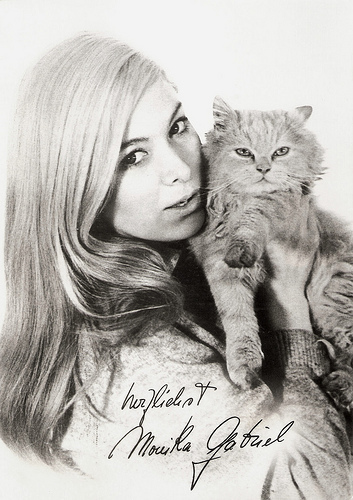
Big East-German card by VEB Progress Film-Vertrieb, Berlin, no.246/698. Photo: Linke.
Scene from Berlin um die Ecke (1965). Source: occ4m (YouTube).
Sources: Jim Morton (East German Cinema Blog), DEFA Film Library, Wikipedia (German) and .

East-German postcard by VEB Progress Film-Vertrieb, Berlin, no. 3320, 1968. Photo: Schwarz.

East-German postcard by VEB Progress Film-Vertrieb, Berlin, no. 3324, 1969. Photo: Schwarz.
The Emperor’s New Clothes
Monika Gabriel was born in Eichenbriick, near Posen (now Poznań) in Germany (now Poland) in 1943. From 1949 on, she grew up in Falkensee, a city near the Baltic Sea, where she began to take ballet lessons at the age of eleven.
From 1957 to 1961 she trained as a professional dancer at the Academy for Artistic Dance and the Staatliche Ballettschule Berlin. From 1962 on, she also played small parts in stage productions at the Berlin Metropol Theater, where she was later transferred to major roles in musical productions like Cole Porter’s Küß mich, Kätchen! (Kiss Me Kate).
However, she was known by the East-German public for her roles in many film and television productions. In 1962, she made her film debut at the DEFA as a page in the fairy tale film Das Kleid/The Robe (Konrad Petzold, 1962) based on Hans Christian Andersen’s fairy tale The Emperor’s New Clothes. Sadly the film was banned by the GDR government as its planned release coincided with the building of the Berlin Wall. Officials saw the film as too critical of the state.
In the next years, she played in the popular Stacheltier stunt film short s Stacheltier: Engel, Sünden und Verkehr/Porcupine: Angels, Sins and Traffic (Horst Seemann, 1963) and Stacheltier: Liebe braucht keine PS/Porcupine: Love Doesn’t Require HP (Horst Seemann, 1964).
Gabriel’s first major role was in Gerhard Klein and Wolfgang Kohlhaase’s Berlin um die Ecke/Berlin Around the Corner (1965), the fourth film in their Berlin Film series. At the East German Cinema Blog , Jim Morton writes: “Unfortunately, this was the same year that the 11th Plenum occurred. By the time the film was finished in 1966, the 11th Plenum had started their ‘Kahlschlag’ (literally ‘clear cutting’), and the film was promptly rejected and shelved. The officials called it ‘dishonest,’ which is an odd thing to say considering it’s one of the most honest films to ever come out of East Germany. They also called it ‘anti-socialist’—an even more absurd claim since the motivation of the main character is his desire to see equity achieved. (…) Like most of the films banned during the 11th Plenum, Berlin Around the Corner didn’t get an official release until after the wall came down, although it did receive a limited screening in 1987. It officially premiered in 1990 to positive reviews. “
Next Monika Gabriel appeared in Ein Lord am Alexanderplatz/A Lord at Alexanderplatz (1967), Wir lassen uns scheiden/We’re Getting Divorced (Ingrid Reschke, 1967) about the impact of divorce on children, and Jungfer, Sie gefällt mir/Maiden, You Please Me (Günter Reisch,1969), with a script by Jurek Becker based on Heinrich von Kleist’s Der zerbrochene Krug. Monika Gabriel fell in love with her co-star in the film, the West German actor Wolfgang Kieling, who had recently moved to the GDR. In the following year they married.

East-German postcard by VEB Progress Film-Vertrieb, Berlin, no. 3047, 1968. Photo: Balinski.
Exit Permit
In 1971, when Wolfgang Kieling returned to the Federal Republic of Germany, Monika Gabriel also received an exit permit. Her final GDR film was Anflug Alpha 1/Approach Alpha I (János Veiczi, 1971) with Alfred Müller and Polish-born actor Stefan Lisewski .
From then on, Monika Gabriel mainly played in television productions such as episodes of Krimi series like Dem Täter auf der Spur/The Perpetrator on the Trail (Jürgen Roland, 1972), Tatort/Crime Scene (1975) and Derrick (1977).
She also appeared in the TV film Die Rakete/The Rocket (Dieter Wedel, 1975) and she had guest spots in such series as St. Pauli-Landungsbrücken/St. Pauli-Jetties (1979), Auf Achse/On Axis (1981), Der König und sein Narr/The King and His Fool (Frank Beyer, 1981) with Wolfgang Kieling and Götz George , Kreisbrandmeister Felix Martin/ Fire Chief Felix Martin (Harald Philipp, 1982) also with Kieling, and Eine Klasse für sich/A Class of its Own (Frank Strecker, 1984).
In 1985, she played her last TV role in an episode of the TV series Berliner Weiße mit Schuß/Berliner Weisse with a Shot (Wilfried Dotzel, 1985) with Günther Pfitzmann and Brigitte Mira .
Monika Gabriel also worked as a synchronisation director, dialogue author and voice actor. She lent her voice to numerous prominent international colleagues, among others Jill Clayburgh, Charlotte Rampling , Stella Stevens and Liv Ullmann. In addition, her voice was heard on many radio plays. She was the German voice of Teela in the Masters of the Universe Radio play (1984-1987).
Monika Gabriel was married four times: with the actors Stefan Lisewski , Armin Mueller-Stahl and Wolfgang Kieling (until 1975) and in a fourth marriage with the TV director Wilfried Dotzel. In 1992, she married Dotzel, but he died a year later. She never remarried again.
At the age of 63, Monika Gabriel succumbed to cancer in 2007 in Berlin-Spandau. She was buried in Falkensee.

Big East-German card by VEB Progress Film-Vertrieb, Berlin, no.246/698. Photo: Linke.
Scene from Berlin um die Ecke (1965). Source: occ4m (YouTube).
Sources: Jim Morton (East German Cinema Blog), DEFA Film Library, Wikipedia (German) and .
Published on December 05, 2017 22:00
December 4, 2017
Victor Boucher
Victor Boucher (1877–1942) was a French stage and screen actor, who was popular as a comedian of the early French sound cinema.
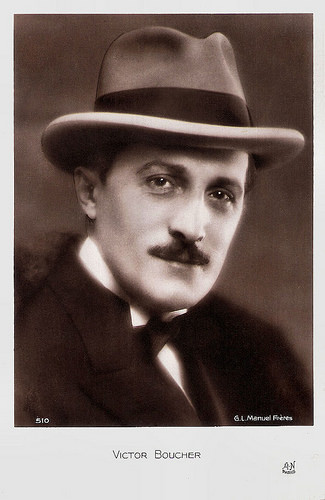
French postcard by A.N., Paris, no. 510. Photo: G.L. Manuel Frères.
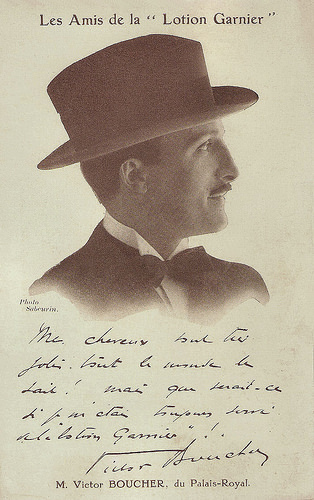
French postcard by Les Amis de la "Lotion Garnier". Photo: Sabeurin. Caption: M. Victor Boucher, du Palais-Royal.
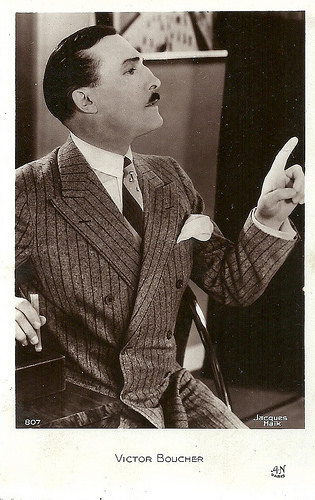
French postcard by A.N., Paris, no. 807. Photo: Jacques Haïk.
Talent as a Comedian
Victor Louis Armand Boucher was born in 1877 in Rouen, France, in a house in the Rue Saint-Étienne-des-Tonneliers. His parents ran a café-restaurant in Bihorel.
As a child, Victor Boucher is fascinated by the theatre shows in his hometown. At the age of 10, he was admitted to the Cercle de jeunesse, where he started to act. After working as a bookkeeper in Rouen and doing his military service, he moved to Paris.
On the recommendation of the composer Edouard Mahé, he ended up obtaining an engagement at the Théâtre des Capucines. In 1902, Victor Boucher married Mariotta Claire at Neufchâtel-en-Bray.
He knows his first success at the Théâtre des Mathurins in the play Kangourou, where actor-director Sacha Guitry spotted him. In 1905, he was lucky to replace an ill actor in the play Nono at the Théâtre des Mathurins and soon he became known for his talent as a comedian.
From 1905 till 1907, he performed at the Theatre de Vaudeville, from 1907 till 1908 at the Theatre de la Renaissance, and so on.
In 1913 Victor Boucher also started to act in the cinema. He made his film debut in La Petite Chocolatière/The Chocolate Girl (1913) by André Liabel, followed by L'Idée de Françoise/The idea of Françoise (Emile Chautard, 1914) with Renée Sylvaire .
However, in the 1920s, he was foremost a stage actor, first at the Théâtre du Gymnase, later at the Théâtre de la Michodière.
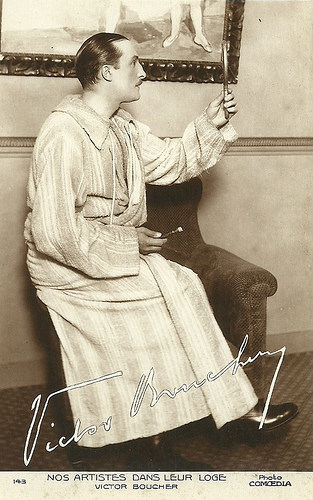
French postcard. Nos artistes dans leur loge, No. 143. Photo Comoedia.
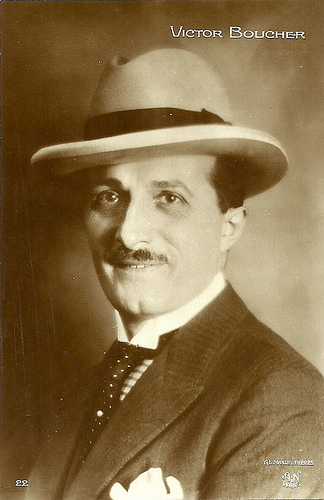
French postcard by A.N., Paris, no. 22. Photo: G.L. Manuel Frères.
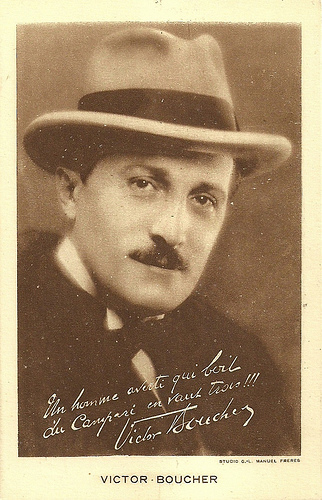
French postcard for Campari. Photo: Studio G.L. Manuel Frères. Caption: "Un homme averti qui boit du Campari en vaut trois!!!" (A man forewarned who drinks Campari equals three).
Prolific Film Actor
In 1927, Victor Boucher became the manager of Théâtre de la Michodière, which became his fixed theatre between the late 1920s and 1940. Boucher also became chair of the Association des artistes dramatiques.
When sound film arrived in France, Boucher became a prolific film actor as well. He played in such early sound films as La douceur d'aimer/The Sweetness of Loving (René Hervil, 1930) and Gagne ta vie/Earn your life (André Berthomieu, 1931) with Dolly Davis . He then starred in the comedy Les vignes du seigneur/Our Lord's Vineyard (René Hervil, 1932) with Simone Cerdan and Victor Garland.
Most of the light comedies Boucher made between 1930 and 1941 are now forgotten. None made it into he canon of French film history. In the comedy Le sexe faible/The Weaker Sex (Robert Siodmak, 1933), Boucher is a stylish butler who is involved in the intrigues of his patrons. It was based on a 1929 stage farce of the same name by Édouard Bourdet, and his co-stars were Mireille Balin and Pierre Brasseur .
Boucher also acted oppositie Mona Goya in La Banque Némo/Nemo's Bank (Marguerite Viel, 1934).He played a man, who rises from the gutter to become a leading banker. His involvement in dishonest financial dealings threaten the collapse of his empire, but he is rescued by the various politicians who have interests in the firm. The plot has strong similarities to the Stavisky Affair which took place the year the film was released.
In the late 1930s, Victor Boucher was often paired with Elvire Popesco, such as in L'habit vert/The Green Jacket (Roger Richebé, 1937), a farce set against the backdrop of the Académie française, a philanthropic organisation created in 1940 by Baron Taylor. His last film was the comedy Ce n'est pas moi/It's not Me (Jacques de Baroncelli, 1941) with Jean Tissier and Ginette Leclerc .
In 1942, Victor Boucher died in Ville-d'Avray, France, from a heart attack. He was 64. Christian Grenier at l'Encinematheque : "Victor Boucher was a lovable man, a generous man, highly esteemed in the trade."
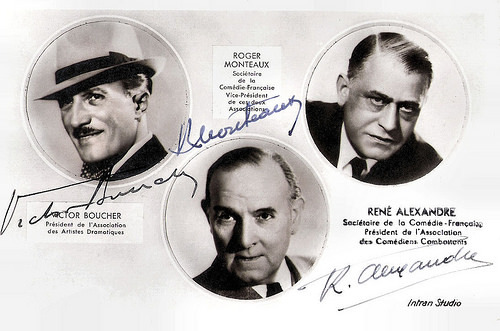
Victor Boucher, Roger Monteaux and René Alexandre . French postcard. Photos: Intran Studio.
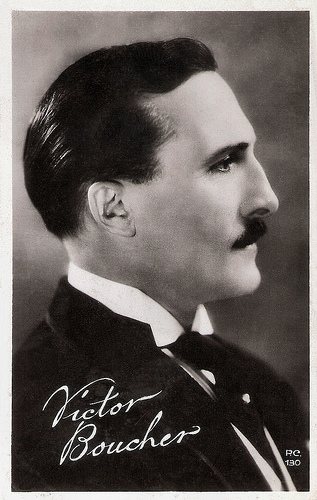
French postcard by P.C., Paris, no. 130.
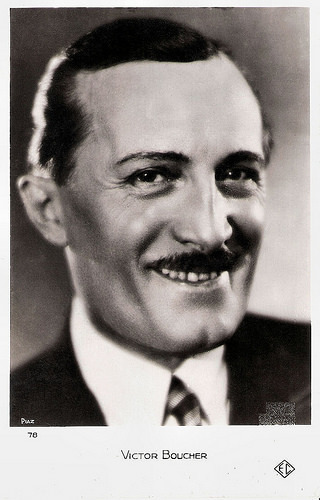
French postcard by Éditions Chantal (EC), Paris, no. 78. Photo: Piaz.
Sources: Christian Grenier (l'Encinemathèque - French), Wikipedia (French and English), and .

French postcard by A.N., Paris, no. 510. Photo: G.L. Manuel Frères.

French postcard by Les Amis de la "Lotion Garnier". Photo: Sabeurin. Caption: M. Victor Boucher, du Palais-Royal.

French postcard by A.N., Paris, no. 807. Photo: Jacques Haïk.
Talent as a Comedian
Victor Louis Armand Boucher was born in 1877 in Rouen, France, in a house in the Rue Saint-Étienne-des-Tonneliers. His parents ran a café-restaurant in Bihorel.
As a child, Victor Boucher is fascinated by the theatre shows in his hometown. At the age of 10, he was admitted to the Cercle de jeunesse, where he started to act. After working as a bookkeeper in Rouen and doing his military service, he moved to Paris.
On the recommendation of the composer Edouard Mahé, he ended up obtaining an engagement at the Théâtre des Capucines. In 1902, Victor Boucher married Mariotta Claire at Neufchâtel-en-Bray.
He knows his first success at the Théâtre des Mathurins in the play Kangourou, where actor-director Sacha Guitry spotted him. In 1905, he was lucky to replace an ill actor in the play Nono at the Théâtre des Mathurins and soon he became known for his talent as a comedian.
From 1905 till 1907, he performed at the Theatre de Vaudeville, from 1907 till 1908 at the Theatre de la Renaissance, and so on.
In 1913 Victor Boucher also started to act in the cinema. He made his film debut in La Petite Chocolatière/The Chocolate Girl (1913) by André Liabel, followed by L'Idée de Françoise/The idea of Françoise (Emile Chautard, 1914) with Renée Sylvaire .
However, in the 1920s, he was foremost a stage actor, first at the Théâtre du Gymnase, later at the Théâtre de la Michodière.

French postcard. Nos artistes dans leur loge, No. 143. Photo Comoedia.

French postcard by A.N., Paris, no. 22. Photo: G.L. Manuel Frères.

French postcard for Campari. Photo: Studio G.L. Manuel Frères. Caption: "Un homme averti qui boit du Campari en vaut trois!!!" (A man forewarned who drinks Campari equals three).
Prolific Film Actor
In 1927, Victor Boucher became the manager of Théâtre de la Michodière, which became his fixed theatre between the late 1920s and 1940. Boucher also became chair of the Association des artistes dramatiques.
When sound film arrived in France, Boucher became a prolific film actor as well. He played in such early sound films as La douceur d'aimer/The Sweetness of Loving (René Hervil, 1930) and Gagne ta vie/Earn your life (André Berthomieu, 1931) with Dolly Davis . He then starred in the comedy Les vignes du seigneur/Our Lord's Vineyard (René Hervil, 1932) with Simone Cerdan and Victor Garland.
Most of the light comedies Boucher made between 1930 and 1941 are now forgotten. None made it into he canon of French film history. In the comedy Le sexe faible/The Weaker Sex (Robert Siodmak, 1933), Boucher is a stylish butler who is involved in the intrigues of his patrons. It was based on a 1929 stage farce of the same name by Édouard Bourdet, and his co-stars were Mireille Balin and Pierre Brasseur .
Boucher also acted oppositie Mona Goya in La Banque Némo/Nemo's Bank (Marguerite Viel, 1934).He played a man, who rises from the gutter to become a leading banker. His involvement in dishonest financial dealings threaten the collapse of his empire, but he is rescued by the various politicians who have interests in the firm. The plot has strong similarities to the Stavisky Affair which took place the year the film was released.
In the late 1930s, Victor Boucher was often paired with Elvire Popesco, such as in L'habit vert/The Green Jacket (Roger Richebé, 1937), a farce set against the backdrop of the Académie française, a philanthropic organisation created in 1940 by Baron Taylor. His last film was the comedy Ce n'est pas moi/It's not Me (Jacques de Baroncelli, 1941) with Jean Tissier and Ginette Leclerc .
In 1942, Victor Boucher died in Ville-d'Avray, France, from a heart attack. He was 64. Christian Grenier at l'Encinematheque : "Victor Boucher was a lovable man, a generous man, highly esteemed in the trade."

Victor Boucher, Roger Monteaux and René Alexandre . French postcard. Photos: Intran Studio.

French postcard by P.C., Paris, no. 130.

French postcard by Éditions Chantal (EC), Paris, no. 78. Photo: Piaz.
Sources: Christian Grenier (l'Encinemathèque - French), Wikipedia (French and English), and .
Published on December 04, 2017 22:00
December 3, 2017
Nina Hagen
German singer, songwriter, and actress Nina Hagen (1955) is known for her theatrical vocals and is often referred to as the ‘Godmother of Punk due to her prominence during the punk and new wave movements in the late 1970s and early 1980s. During her 40-years-career she appeared in several European films.
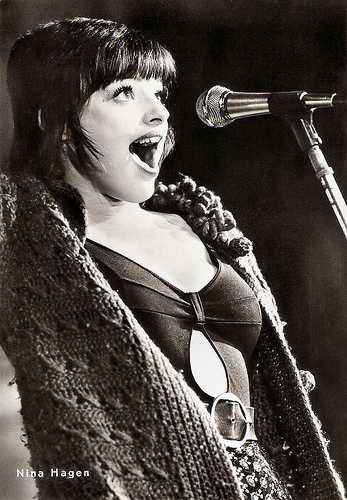
East-German postcard by VEB Progress Film-Verleih, Berlin, no. 147/75. Photo: DEFA.
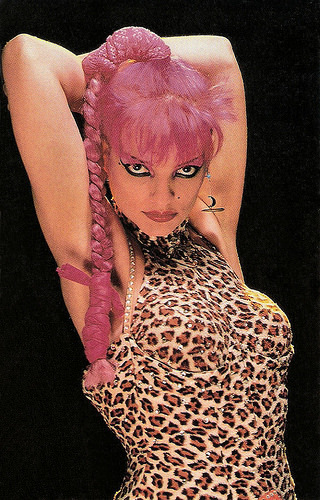
American postcard by Coral-Lee, Rancho Cordova, no. CL/Personality # 132.
You Forgot the Colour Film
Catharina ’Nina’ Hagen was born in 1955) in the former East Berlin, German Democratic Republic. She was the daughter of scriptwriter Hans Hagen and actress and singer Eva-Maria Hagen (née Buchholz). Her paternal grandfather died in the Sachsenhausen concentration camp (her father was Jewish). Her parents divorced when she was two years old, and growing up, she saw her father infrequently.
At age four, she began to study ballet, and was considered an opera prodigy by the time she was nine. When Hagen was 11, her mother married Wolf Biermann, an anti-establishment singer-songwriter. Biermann's political views later influenced young Hagen.
Hagen left school at age sixteen and went to Poland, where she began her career. She later returned to Germany and joined the cover band, Fritzens Dampferband (Fritzen's Steamboat Band). She added songs by Janis Joplin and Tina Turner to the ‘allowable’ set lists during shows.
From 1972 to 1973, Hagen enrolled in the crash-course performance program at The Central Studio for Light Music in East Berlin. Upon graduating, she formed the band Automobil and released in 1974 the single Du hast den Farbfilm vergessen (You Forgot the Colour Film), a subtle dig mocking the sterile, grey, Communist state. Nina became one of the country's best-known young stars.
Hagen also appeared in several East-German films and TV films sometimes alongside her mother Eva-Maria Hagen , including Heiraten/Weiblich/Marrying/Female (Christa Kulosa, 1975), Heute ist Freitag/Today is Friday (Klaus Gendries, 1975), Liebesfallen/Love Traps (Werner W. Wallroth, 1976) and Unser stiller Mann/Our Quite Man (Bernhard Stephan, 1976).
Her career in the GDR was cut short after her stepfather Wolf Biermann's East German citizenship was withdrawn from him in 1976. Hagen and her mother followed him westwards to Hamburg. The circumstances surrounding the family's emigration were exceptional: Biermann was granted permission to perform a televised concert in Cologne, but denied permission to re-cross the border to his adopted home country.
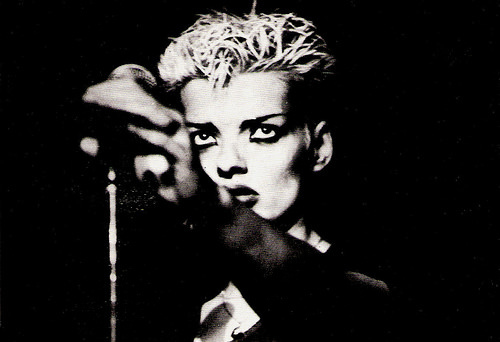
Vintage postcard.
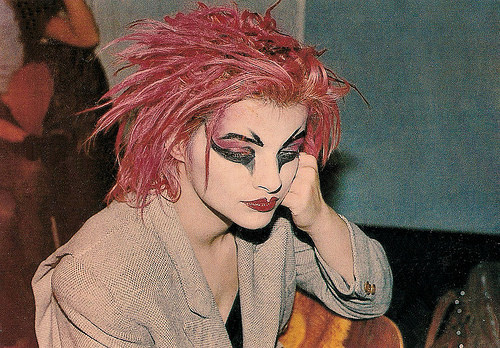
Vintage postcard.
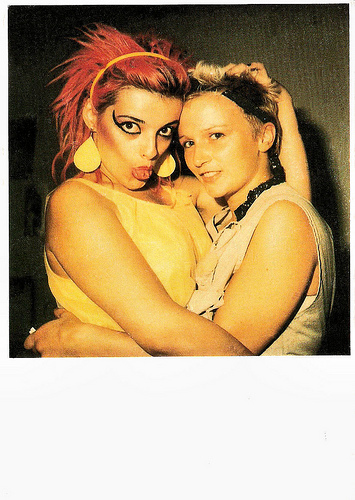
Dutch postcard by Art Unlimited, Amsterdam, no. C 1930. Photo: Bettie Ringma, 1980. Caption: Nina Hagen with Sacha, New York.
Nina Hagen Band
Nina Hagen was offered a record deal from CBS Records. Her label advised her to acclimatise herself to Western culture through travel, and she arrived in London during the height of the punk rock movement. Hagen was quickly taken up by a circle that included The Slits and The Sex Pistols .
Back in Germany by mid-1977, Hagen formed the Nina Hagen Band in West Berlin's Kreuzberg district. In 1978 they released their self-titled debut album, Nina Hagen Band, which included the single TV-Glotzer (a cover of White Punks on Dope by The Tubes, though with entirely different German lyrics), and Auf'm Bahnhof Zoo, about West Berlin's then-notorious Berlin Zoologischer Garten station. The album also included a version of Rangehn (Go for It), a song she had previously recorded in East Germany, but with different music.
The album received critical acclaim for its hard rock sound and for Hagen's theatrical vocals, far different from the straightforward singing of her East German recordings. It was a commercial success selling over 250,000 copies. Relations between Hagen and the other band members deteriorated over the course of the subsequent European tour. The band released one more album Unbehagen (Unease) before their break-up in 1979. It included the single African Reggae and Wir Leben Immer... Noch, a German language cover of Lene Lovich's Lucky Number.
Meanwhile, Hagen's public persona was steadily creating media uproar. She starred in two films. In Germany she made the experimental film Bildnis Einer Trinkerin/Portrait of a Female Drunkard (Ulrike Ottinger, 1979) with Tabea Blumenschein, Magdalena Montezuma and Eddie Constantine . She also acted with Dutch rocker Herman Brood and singer Lene Lovich in the Dutch film Cha Cha (Herbert Curiel, 1979). Brood and Hagen would have a long romantic relationship that would end when Hagen could no longer tolerate Brood's drug abuse. She would refer to Brood as her ‘soulmate’ long after Brood committed suicide in 2001.
In late 1980, Hagen discovered she was pregnant, broke up with the father-to-be the Dutch guitarist Ferdi Karmelk, who died in 1988, and she moved to Los Angeles. Her daughter, Cosma Shiva Hagen, was born in Santa Monica in 1981. In 1982, Hagen signed a new contract with CBS and released her debut solo album NunSexMonkRock, a dissonant mix of punk, funk, reggae, and opera. Her first English-language album became also her first record to chart in the United States.
She then went on a world tour with the No Problem Orchestra. Her next album the Giorgio Moroder-produced Fearless (1983), generated two major club hits in America, Zarah (a cover of the Zarah Leander song Ich weiss, es wird einmal ein Wunder geschehen) and the disco/punk/opera song, New York New York, which reached no. 9 in the USA dance charts.
She followed this with one more album, Nina Hagen in Ekstasy (1985), which featured a 1979 recording of her hardcore punk take on Paul Anka's My Way. The album fared less well and her contract with CBS expired in 1986 and was not renewed. Hagen's public appearances became stranger and frequently included discussions of God, UFOs, her social and political beliefs, animal rights and vivisection, and claims of alien sightings. In 1987 she released the Punk Wedding EP independently, a celebration of her marriage to a 18-year-old punk South African nicknamed 'Iroquois'.
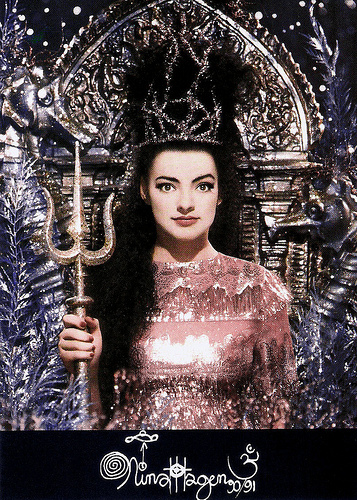
German promotion card by Mercury / Nina Hagen-Fanclub, Erlangen. Image: Pierre et Gilles.
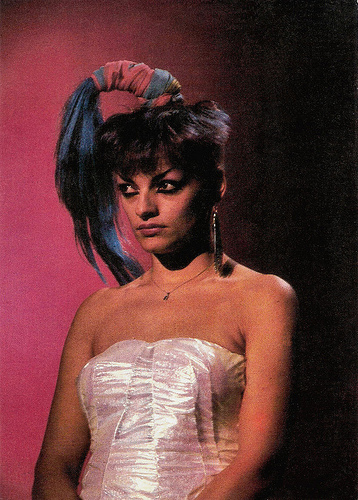
French postcard by Editions F. Nugeron in the Chanteurs series, no. 8. Photo: B. Alary.
Return of the Mother
In 1989, Nina Hagen was offered a record deal from Mercury Records. She released three albums on the label: Nina Hagen (1989), Street (1991), and Revolution Ballroom (1993). However, none of the albums achieved notable commercial success. In 1989 she had a relationship with Frank Chevallier from France, with whom she has a son, Otis Chevallier-Hagen (b. 1990). In 1992 Hagen became the host of a TV show on RTLplus. She also collaborated with Adamski on the single Get Your Body (1992).
In the 1990s, Hagen lived in Paris with her daughter Cosma Shiva and son Otis. In 1996, she married David Lynn, who is fifteen years younger, but divorced him in the beginning of 2000. In 1999, Hagen became the host of Sci-Fright, a weekly science fiction show on the British Sci-Fi Channel. That year, she also played the role of Celia Peachum in The Threepenny Opera by Kurt Weill and Bertolt Brecht, alongside Max Raabe.
She also appeared as a witch in the German-Russian fairy-tale film Vasilisa (Elena Shatalova, 2000). At IMDb, Howard Roarschawks writes: “I saw this eye-popping film at the 2001 Sarasota Film Festival. I entered the theater without expectations, having chosen the film randomly. From shot one, my jaw dropped slack and my eyes waxed wide. Vasilisa is a gorgeously filmed, brilliantly scripted, boldly acted, confidently directed, lushly designed masterpiece of unseen cinema.”
Hagen made her musical comeback with the release of her album Return of the Mother (2000). In 2001 she collaborated with Rosenstolz and Marc Almond on the single Total eclipse/Die schwarze Witwe that reached no. 22 in Germany. Later albums include Big Band Explosion (2003), in which she sang numerous swing covers with her then husband, Danish singer and performer Lucas Alexander. This was followed by Heiß, a greatest hits album. The following album, Journey to the Snow Queen, is more of an audio book — Hagen reads the Snow Queen fairy tale with Tchaikovsky's The Nutcracker in the background.
Besides her musical career, Hagen is also a voice-over actress. She dubbed the voice of Sally in Der Albtraum vor Weihnachten, the German release of Tim Burton's The Nightmare before Christmas (1993), and she has also done voice work on the German animation film Hot Dogs: Wau - wir sind reich!/Millionaire Dogs (Michael Schoemann, 1999).
Hagen appeared as the Queen opposite Otto Waalkes and her daughter Cosma Shiva Hagen as Snowwhite in the comedy 7 Zwerge – Männer allein im Wald/7 Dwarves – Men Alone in the Wood (Sven Unterwaldt Jr., 2004) which follows the fairy tale by the Brothers Grimm. It was the second most popular film in German cinemas in 2004, reaching an audience of almost 7 million. She returned in the sequel 7 Zwerge – Der Wald ist nicht genug/Seven Dwarves - The Forest Is Not Enough (Sven Unterwaldt, 2006).
Nina Hagen wrote three autobiographies: Ich bin ein Berliner (1988), Nina Hagen: That's Why the Lady Is a Punk (2003), and Bekenntnisse (2010). She is also noted for her human and animal rights activism. After a four-year lapse Nina Hagen released the album Personal Jesus in 2010. William Ruhlmann at AllMusic : “Personal Jesus, which featured 13 faith-based tracks that dutifully blend rock, blues, soul, and gospel into a sound that’s distinctly hers.” It was followed by Volksbeat (2011).
Her latest films are Desire Will Set You Free (Yony Leyser, 2015) with Amber Benson and Rosa von Praunheim and Gutterdämmerung (Bjorn Tagemose, 2016) with Henry Rollins, Grace Jones and Iggy Pop.
Nina Hagen performs Du hast den Farbfilm vergessen. Source: PakoChile (YouTube).
Nina Hagen performs Auf'm Bahnhof Zoo live. Source: Fritz 12345 (YouTube).
Trailer Cha Cha (1979). Source: Thomas Crommentuyn (YouTube).
Nina Hagen performs Zarah. Source: B DPb (YouTube).
Sources: William Ruhlmann (AllMusic), Wikipedia and .

East-German postcard by VEB Progress Film-Verleih, Berlin, no. 147/75. Photo: DEFA.

American postcard by Coral-Lee, Rancho Cordova, no. CL/Personality # 132.
You Forgot the Colour Film
Catharina ’Nina’ Hagen was born in 1955) in the former East Berlin, German Democratic Republic. She was the daughter of scriptwriter Hans Hagen and actress and singer Eva-Maria Hagen (née Buchholz). Her paternal grandfather died in the Sachsenhausen concentration camp (her father was Jewish). Her parents divorced when she was two years old, and growing up, she saw her father infrequently.
At age four, she began to study ballet, and was considered an opera prodigy by the time she was nine. When Hagen was 11, her mother married Wolf Biermann, an anti-establishment singer-songwriter. Biermann's political views later influenced young Hagen.
Hagen left school at age sixteen and went to Poland, where she began her career. She later returned to Germany and joined the cover band, Fritzens Dampferband (Fritzen's Steamboat Band). She added songs by Janis Joplin and Tina Turner to the ‘allowable’ set lists during shows.
From 1972 to 1973, Hagen enrolled in the crash-course performance program at The Central Studio for Light Music in East Berlin. Upon graduating, she formed the band Automobil and released in 1974 the single Du hast den Farbfilm vergessen (You Forgot the Colour Film), a subtle dig mocking the sterile, grey, Communist state. Nina became one of the country's best-known young stars.
Hagen also appeared in several East-German films and TV films sometimes alongside her mother Eva-Maria Hagen , including Heiraten/Weiblich/Marrying/Female (Christa Kulosa, 1975), Heute ist Freitag/Today is Friday (Klaus Gendries, 1975), Liebesfallen/Love Traps (Werner W. Wallroth, 1976) and Unser stiller Mann/Our Quite Man (Bernhard Stephan, 1976).
Her career in the GDR was cut short after her stepfather Wolf Biermann's East German citizenship was withdrawn from him in 1976. Hagen and her mother followed him westwards to Hamburg. The circumstances surrounding the family's emigration were exceptional: Biermann was granted permission to perform a televised concert in Cologne, but denied permission to re-cross the border to his adopted home country.

Vintage postcard.

Vintage postcard.

Dutch postcard by Art Unlimited, Amsterdam, no. C 1930. Photo: Bettie Ringma, 1980. Caption: Nina Hagen with Sacha, New York.
Nina Hagen Band
Nina Hagen was offered a record deal from CBS Records. Her label advised her to acclimatise herself to Western culture through travel, and she arrived in London during the height of the punk rock movement. Hagen was quickly taken up by a circle that included The Slits and The Sex Pistols .
Back in Germany by mid-1977, Hagen formed the Nina Hagen Band in West Berlin's Kreuzberg district. In 1978 they released their self-titled debut album, Nina Hagen Band, which included the single TV-Glotzer (a cover of White Punks on Dope by The Tubes, though with entirely different German lyrics), and Auf'm Bahnhof Zoo, about West Berlin's then-notorious Berlin Zoologischer Garten station. The album also included a version of Rangehn (Go for It), a song she had previously recorded in East Germany, but with different music.
The album received critical acclaim for its hard rock sound and for Hagen's theatrical vocals, far different from the straightforward singing of her East German recordings. It was a commercial success selling over 250,000 copies. Relations between Hagen and the other band members deteriorated over the course of the subsequent European tour. The band released one more album Unbehagen (Unease) before their break-up in 1979. It included the single African Reggae and Wir Leben Immer... Noch, a German language cover of Lene Lovich's Lucky Number.
Meanwhile, Hagen's public persona was steadily creating media uproar. She starred in two films. In Germany she made the experimental film Bildnis Einer Trinkerin/Portrait of a Female Drunkard (Ulrike Ottinger, 1979) with Tabea Blumenschein, Magdalena Montezuma and Eddie Constantine . She also acted with Dutch rocker Herman Brood and singer Lene Lovich in the Dutch film Cha Cha (Herbert Curiel, 1979). Brood and Hagen would have a long romantic relationship that would end when Hagen could no longer tolerate Brood's drug abuse. She would refer to Brood as her ‘soulmate’ long after Brood committed suicide in 2001.
In late 1980, Hagen discovered she was pregnant, broke up with the father-to-be the Dutch guitarist Ferdi Karmelk, who died in 1988, and she moved to Los Angeles. Her daughter, Cosma Shiva Hagen, was born in Santa Monica in 1981. In 1982, Hagen signed a new contract with CBS and released her debut solo album NunSexMonkRock, a dissonant mix of punk, funk, reggae, and opera. Her first English-language album became also her first record to chart in the United States.
She then went on a world tour with the No Problem Orchestra. Her next album the Giorgio Moroder-produced Fearless (1983), generated two major club hits in America, Zarah (a cover of the Zarah Leander song Ich weiss, es wird einmal ein Wunder geschehen) and the disco/punk/opera song, New York New York, which reached no. 9 in the USA dance charts.
She followed this with one more album, Nina Hagen in Ekstasy (1985), which featured a 1979 recording of her hardcore punk take on Paul Anka's My Way. The album fared less well and her contract with CBS expired in 1986 and was not renewed. Hagen's public appearances became stranger and frequently included discussions of God, UFOs, her social and political beliefs, animal rights and vivisection, and claims of alien sightings. In 1987 she released the Punk Wedding EP independently, a celebration of her marriage to a 18-year-old punk South African nicknamed 'Iroquois'.

German promotion card by Mercury / Nina Hagen-Fanclub, Erlangen. Image: Pierre et Gilles.

French postcard by Editions F. Nugeron in the Chanteurs series, no. 8. Photo: B. Alary.
Return of the Mother
In 1989, Nina Hagen was offered a record deal from Mercury Records. She released three albums on the label: Nina Hagen (1989), Street (1991), and Revolution Ballroom (1993). However, none of the albums achieved notable commercial success. In 1989 she had a relationship with Frank Chevallier from France, with whom she has a son, Otis Chevallier-Hagen (b. 1990). In 1992 Hagen became the host of a TV show on RTLplus. She also collaborated with Adamski on the single Get Your Body (1992).
In the 1990s, Hagen lived in Paris with her daughter Cosma Shiva and son Otis. In 1996, she married David Lynn, who is fifteen years younger, but divorced him in the beginning of 2000. In 1999, Hagen became the host of Sci-Fright, a weekly science fiction show on the British Sci-Fi Channel. That year, she also played the role of Celia Peachum in The Threepenny Opera by Kurt Weill and Bertolt Brecht, alongside Max Raabe.
She also appeared as a witch in the German-Russian fairy-tale film Vasilisa (Elena Shatalova, 2000). At IMDb, Howard Roarschawks writes: “I saw this eye-popping film at the 2001 Sarasota Film Festival. I entered the theater without expectations, having chosen the film randomly. From shot one, my jaw dropped slack and my eyes waxed wide. Vasilisa is a gorgeously filmed, brilliantly scripted, boldly acted, confidently directed, lushly designed masterpiece of unseen cinema.”
Hagen made her musical comeback with the release of her album Return of the Mother (2000). In 2001 she collaborated with Rosenstolz and Marc Almond on the single Total eclipse/Die schwarze Witwe that reached no. 22 in Germany. Later albums include Big Band Explosion (2003), in which she sang numerous swing covers with her then husband, Danish singer and performer Lucas Alexander. This was followed by Heiß, a greatest hits album. The following album, Journey to the Snow Queen, is more of an audio book — Hagen reads the Snow Queen fairy tale with Tchaikovsky's The Nutcracker in the background.
Besides her musical career, Hagen is also a voice-over actress. She dubbed the voice of Sally in Der Albtraum vor Weihnachten, the German release of Tim Burton's The Nightmare before Christmas (1993), and she has also done voice work on the German animation film Hot Dogs: Wau - wir sind reich!/Millionaire Dogs (Michael Schoemann, 1999).
Hagen appeared as the Queen opposite Otto Waalkes and her daughter Cosma Shiva Hagen as Snowwhite in the comedy 7 Zwerge – Männer allein im Wald/7 Dwarves – Men Alone in the Wood (Sven Unterwaldt Jr., 2004) which follows the fairy tale by the Brothers Grimm. It was the second most popular film in German cinemas in 2004, reaching an audience of almost 7 million. She returned in the sequel 7 Zwerge – Der Wald ist nicht genug/Seven Dwarves - The Forest Is Not Enough (Sven Unterwaldt, 2006).
Nina Hagen wrote three autobiographies: Ich bin ein Berliner (1988), Nina Hagen: That's Why the Lady Is a Punk (2003), and Bekenntnisse (2010). She is also noted for her human and animal rights activism. After a four-year lapse Nina Hagen released the album Personal Jesus in 2010. William Ruhlmann at AllMusic : “Personal Jesus, which featured 13 faith-based tracks that dutifully blend rock, blues, soul, and gospel into a sound that’s distinctly hers.” It was followed by Volksbeat (2011).
Her latest films are Desire Will Set You Free (Yony Leyser, 2015) with Amber Benson and Rosa von Praunheim and Gutterdämmerung (Bjorn Tagemose, 2016) with Henry Rollins, Grace Jones and Iggy Pop.
Nina Hagen performs Du hast den Farbfilm vergessen. Source: PakoChile (YouTube).
Nina Hagen performs Auf'm Bahnhof Zoo live. Source: Fritz 12345 (YouTube).
Trailer Cha Cha (1979). Source: Thomas Crommentuyn (YouTube).
Nina Hagen performs Zarah. Source: B DPb (YouTube).
Sources: William Ruhlmann (AllMusic), Wikipedia and .
Published on December 03, 2017 22:00
December 2, 2017
Susannah York
Lovely and free-spirited English film, stage and television actress Susannah York (1939-2011) epitomised the sensuality of the swinging Sixties. Her appearances in various hit films of the 1960s formed the basis of her international reputation. She was awarded a BAFTA as Best Supporting Actress for They Shoot Horses, Don't They? (1969) and was nominated for an Oscar and Golden Globe for the same film. For Images, she won the Best Actress award at the 1972 Cannes Film Festival.
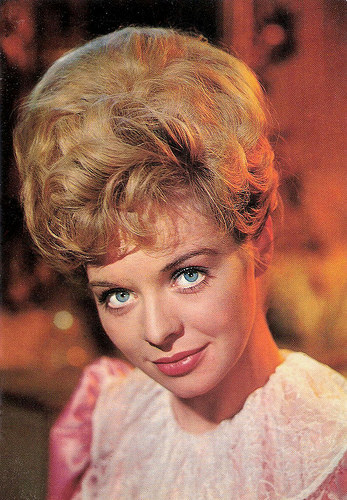
Spanish postcard by Postal Oscarcolor. Photo: publicity still for Freud: The Secret Passion (John Huston, 1962).
Free-spirited and unreserved
Susannah York was born Susannah Yolande Fletcher in Chelsea, London, in 1939. She was the younger daughter of Simon William Peel Vickers Fletcher, a merchant banker and steel magnate, and his first wife, the former Joan Nita Mary Bowring. They married in 1935 and divorced prior to 1943. York had an elder sister, as well as a half-brother, Eugene.
In early 1943, her mother married a Scottish businessman, Adam M. Hamilton, and moved, with her daughter, to a remote village in Scotland. At the age of 11, York entered Marr College in Troon, Ayrshire. Later she became a boarder at Wispers School in the Sussex village of Stedham. At 13 she was expelled from Wispers after admitting to a nude midnight swim in the school pool, and she transferred to East Haddon Hall in Northamptonshire.
Enthusiastic about her experiences of acting at school (she had played an Ugly Sister in Cinderella at the age of nine), York first decided to apply to the Glasgow College of Dramatic Art; but after her mother had separated from her stepfather and moved to London, she instead auditioned for the Royal Academy of Dramatic Arts (RADA). There she won the Ronson award for most promising student before graduating in 1958.
The fair-haired York with her dreamy blue eyes performed classical repertory and pantomime in her early professional career. In 1959, she married Michael Wells, with whom she had two children, daughter Sasha (born May 1972) and son Orlando (born June 1973). They divorced in 1976.
She made an impression on television in a production of The Crucible (Henry Kaplan, 1959) as Abigail Williams opposite Sean Connery as John Proctor. Her film career began with the drama Tunes of Glory (Ronald Neame, 1960), co-starring with Alec Guinness and John Mills . She also appeared in the Norman Wisdom comedy There Was a Crooked Man (Stuart Burge, 1960).
The following year, she played the leading role in the coming-of age drama The Greengage Summer (Lewis Gilbert, 1961), which co-starred Kenneth More and Danielle Darrieux . Next, she performed in the American film Freud: The Secret Passion (John Huston, 1962) with Montgomery Clift as Austrian psychoanalyst Sigmund Freud. The pseudobiographical drama compresses the years it took Freud to develop his psychoanalytic theories into what seems like a few months. Nearly every neurotic symptom imaginable manifests itself in one patient, Cecily Koertner (York), who is sexually repressed, hysterical, and fixated on her father.
Then, York played brazenly seductive Sophie Western in the bawdy and robust 18th century tale Tom Jones (Tony Richardson, 1963) opposite Albert Finney as the bed-hopping title rogue. Henry Fielding's classic novel was adapted for the screen by playwright John Osborne. It became one of the most critically acclaimed and popular comedies of its time, winning the Oscar for Best Film and three other Oscars and three BAFTA awards. Tom Jones was the third most popular at the British box office in 1963, and the 4th most popular in the United States. The film made York an international star. Roger Philip Mellor in the Encyclopedia of British Film: "With peaches-and-cream complexion, she was a cameraman's dream."
Opposite Warren Beatty, York played a a trendy Hampstead boutique owner in the crime film Kaleidoscope (Jack Smight, 1966). She also appeared in the biographical drama and Academy Award winner A Man for All Seasons (Fred Zinnemann, 1966) with Paul Scofield as Sir Thomas More, and in the groundbreaking lesbian drama The Killing of Sister George (Robert Aldrich, 1968). Gary Brumburgh at IMDb : “Free-spirited and unreserved, she had no trouble at all courting controversy in some of the film roles she went on to play.”
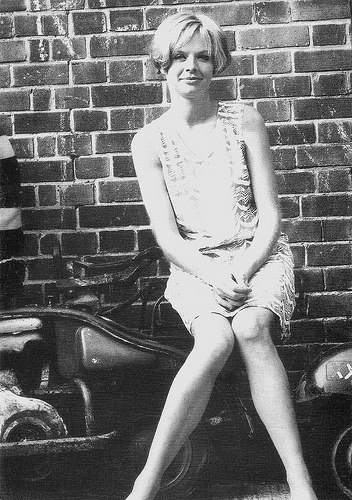
British postcard by the Philip Townsend Archive, no PT111. Photo: Philip Townsend, 1966.
A schizophrenic housewife, engulfed by terrorising apparitions
Susannah York was nominated for a Best Supporting Actress Oscar for They Shoot Horses, Don't They? (Sydney Pollack, 1969). The screenplay by James Poe and Robert E. Thompson is based on the 1935 novel of the same name by Horace McCoy. It focuses on a disparate group of characters desperate to win a Depression-era dance marathon and the opportunistic emcee (Gig Young) who urges them on to victory. The film also stars Jane Fonda , Michael Sarrazin, and Bruce Dern. Young won the Academy Award for Best Supporting Actor, while Fonda and York were nominated for the Academy Awards for Best Actress and Best Supporting Actress respectively. York lost to Goldie Hawn for her role in Cactus Flower (Gene Saks, 1969).
The Second World War film Battle of Britain (Guy Hamilton, 1969)endeavoured to be an accurate account of the Battle of Britain, when in the summer and autumn of 1940 the British RAF inflicted a strategic defeat on the Luftwaffe and so ensured the cancellation of Operation Sea Lion – Adolf Hitler's plan to invade Britain. The film drew many respected British actors to accept roles as key figures of the battle, including Sir Laurence Olivier as Hugh Dowding and Trevor Howard as Keith Park.
The next year, she co-starred with George C. Scott as Edward Rochester in the TV-adaptation of Charlotte Brontë’s Jane Eyre (Delbert Mann, 1970), and was Emmy-nominated for her beautifully nuanced role. She then played in Country Dance (J. Lee Thompson, 1970), one of her favourite films. It is a tragicomedy set in a fading Scottish aristocratic family, in which the drunken Sir Charles Henry Arbuthnot Pinkerton Ferguson ( Peter O'Toole ) has an incestuous relationship with his equally eccentric sister Hilary Dow (York).
In 1972, she won the Best Actress award at the Cannes Film Festival for her role in the British-American psychological horror film Images (Robert Altman, 1972). She played a schizophrenic housewife, engulfed by terrorising apparitions. She kills off each, unknowing if these demons are merely figments of her hallucinatory imagination or part of reality. The film was nominated for a Golden Globe award for Best English-Language Foreign Film, but was not a commercial success.
York focused on her personal life, raising her two children for a time. She wrote two children's fantasy novels, In Search of Unicorns (1973, revised 1984) which was excerpted in the film Images, and Lark's Castle (1976, revised 1986).
On screen, she played Lara, the mother of Superman (Christopher Reeve) in the blockbuster Superman (Richard Donner, 1978) and its sequels, Superman II (Richard Lester, 1980) and Superman IV: The Quest for Peace (Sidney J. Furie, 1987). She divided her time between these commercial films and art-house films like The Maids (Christopher Miles, 1974), The Shout (Jerzy Skolimowski, 1978) and Melancholia (Andi Engel, 1989). However, York failed to recapture the glow of her earlier screen career.
The actress decided to move to the theatre and appeared in 1978 at the New End Theatre in London in The Singular Life of Albert Nobbs with Lucinda Childs, directed by French director Simone Benmussa. This was the first of 10 projects she completed with the producer Richard Jackson. The following year, she appeared in Paris, speaking French in a play by Henry James: Appearances, with Samy Frey . The play was again directed by Benmussa.
Susannah York made extensive appearances in British television series, including Prince Regent (Ian Curteis, 1979), as Maria Fitzherbert, the clandestine wife of the future George IV, and We'll Meet Again (Tony Wharmby a.o., 1982).
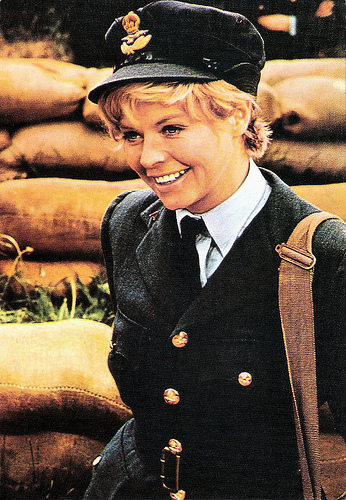
British postcard by Dixon-Lotus Production, no. L6/8705, 1969. Photo: Spitfire Productions Ltd. Publicity still for Battle of Britain (Guy Hamilton, 1969). Caption: Appearing in uniform for the first time in the film The Battle of Britain is lovely Susannah York. She portrays Section Officer Maggie Harvey, one of the W.A.A.F. heroines of the sixteen weeks summer battle of 1940.
Evoking both cheers and jeers
In the 1980s, Susannah York played on stage with Susan Hampshire in Simone Benmussa’s For No Good Reason, an adaptation of George Moore's short story. In 1984, York starred on-screen as Mrs. Cratchit in A Christmas Carol (Clive Donner, 1984), based on the novel by Charles Dickens. George C. Scott starred as Ebenezer Scrooge, and both of her children co-starred as Cratchit offspring. In 1985 she appeared on stage in Fatal Attraction by Bernard Slade at the Theatre Royal Haymarket.
In 1991, she was appointed an Officier de l'Ordre des Arts et des Lettres (Officer of the Order of Arts and Letters) by French culture minister Jack Lang. In 1992, she was a member of the jury at the 42nd Berlin International Film Festival.
On television, York had a recurring role as hospital manager Helen Grant in BBC’s medical drama series Holby City (2003). She reprised this role in two episodes of Holby City's sister series Casualty in 2004.
In 2007, she appeared in the UK tour of The Wings of the Dove, and continued performing her internationally well received solo show, The Loves of Shakespeare's Women. Also in 2007, she guest starred in the Doctor Who audio play Valhalla. She was a patron of the Children's Film Unit and appeared in several of their films. P
Politically, she was left-wing and publicly supported Mordechai Vanunu, the Israeli dissident who revealed Israel's nuclear weapons programme. While performing The Loves of Shakespeare's Women at the Cameri Theatre in Tel Aviv in June 2007, York dedicated the performance to Vanunu, evoking both cheers and jeers from the audience.
In 2007, she also became the grandmother of Rafferty, child of her son Orlando. In 2008, she played the part of Nelly in a stage adaptation by April De Angelis of Wuthering Heights. In 2009, she starred alongside Jos Vantyler in the Tennessee Williams season at the New End Theatre, London for which she received critical acclaim.
Susannah York was diagnosed with cancer in 2010, but she refused chemotherapy in order to honour a contractual obligation to appear as Jean in Ronald Harwood's Quartet, at the Oxford Playhouse in August 2010. It was her last stage appearance. Her final film was The Calling (Jan Dunn, 2009) with Brenda Blethyn and Emily Beecham.
In 2011, Susannah York died at the Royal Marsden Hospital in London from multiple myeloma, six days after her 72nd birthday.
Trailer Tom Jones (1963). Source: Movieclips Trailer Vault (YouTube).
Trailer Battle of Britain (1969). Source: 05HK09 (YouTube).
Spanish trailer Images (1972). Source: versatilhv (YouTube).
Sources: (IMDb), Roger Philip Mellor (Encyclopedia of British Film), Wikipedia and .

Spanish postcard by Postal Oscarcolor. Photo: publicity still for Freud: The Secret Passion (John Huston, 1962).
Free-spirited and unreserved
Susannah York was born Susannah Yolande Fletcher in Chelsea, London, in 1939. She was the younger daughter of Simon William Peel Vickers Fletcher, a merchant banker and steel magnate, and his first wife, the former Joan Nita Mary Bowring. They married in 1935 and divorced prior to 1943. York had an elder sister, as well as a half-brother, Eugene.
In early 1943, her mother married a Scottish businessman, Adam M. Hamilton, and moved, with her daughter, to a remote village in Scotland. At the age of 11, York entered Marr College in Troon, Ayrshire. Later she became a boarder at Wispers School in the Sussex village of Stedham. At 13 she was expelled from Wispers after admitting to a nude midnight swim in the school pool, and she transferred to East Haddon Hall in Northamptonshire.
Enthusiastic about her experiences of acting at school (she had played an Ugly Sister in Cinderella at the age of nine), York first decided to apply to the Glasgow College of Dramatic Art; but after her mother had separated from her stepfather and moved to London, she instead auditioned for the Royal Academy of Dramatic Arts (RADA). There she won the Ronson award for most promising student before graduating in 1958.
The fair-haired York with her dreamy blue eyes performed classical repertory and pantomime in her early professional career. In 1959, she married Michael Wells, with whom she had two children, daughter Sasha (born May 1972) and son Orlando (born June 1973). They divorced in 1976.
She made an impression on television in a production of The Crucible (Henry Kaplan, 1959) as Abigail Williams opposite Sean Connery as John Proctor. Her film career began with the drama Tunes of Glory (Ronald Neame, 1960), co-starring with Alec Guinness and John Mills . She also appeared in the Norman Wisdom comedy There Was a Crooked Man (Stuart Burge, 1960).
The following year, she played the leading role in the coming-of age drama The Greengage Summer (Lewis Gilbert, 1961), which co-starred Kenneth More and Danielle Darrieux . Next, she performed in the American film Freud: The Secret Passion (John Huston, 1962) with Montgomery Clift as Austrian psychoanalyst Sigmund Freud. The pseudobiographical drama compresses the years it took Freud to develop his psychoanalytic theories into what seems like a few months. Nearly every neurotic symptom imaginable manifests itself in one patient, Cecily Koertner (York), who is sexually repressed, hysterical, and fixated on her father.
Then, York played brazenly seductive Sophie Western in the bawdy and robust 18th century tale Tom Jones (Tony Richardson, 1963) opposite Albert Finney as the bed-hopping title rogue. Henry Fielding's classic novel was adapted for the screen by playwright John Osborne. It became one of the most critically acclaimed and popular comedies of its time, winning the Oscar for Best Film and three other Oscars and three BAFTA awards. Tom Jones was the third most popular at the British box office in 1963, and the 4th most popular in the United States. The film made York an international star. Roger Philip Mellor in the Encyclopedia of British Film: "With peaches-and-cream complexion, she was a cameraman's dream."
Opposite Warren Beatty, York played a a trendy Hampstead boutique owner in the crime film Kaleidoscope (Jack Smight, 1966). She also appeared in the biographical drama and Academy Award winner A Man for All Seasons (Fred Zinnemann, 1966) with Paul Scofield as Sir Thomas More, and in the groundbreaking lesbian drama The Killing of Sister George (Robert Aldrich, 1968). Gary Brumburgh at IMDb : “Free-spirited and unreserved, she had no trouble at all courting controversy in some of the film roles she went on to play.”

British postcard by the Philip Townsend Archive, no PT111. Photo: Philip Townsend, 1966.
A schizophrenic housewife, engulfed by terrorising apparitions
Susannah York was nominated for a Best Supporting Actress Oscar for They Shoot Horses, Don't They? (Sydney Pollack, 1969). The screenplay by James Poe and Robert E. Thompson is based on the 1935 novel of the same name by Horace McCoy. It focuses on a disparate group of characters desperate to win a Depression-era dance marathon and the opportunistic emcee (Gig Young) who urges them on to victory. The film also stars Jane Fonda , Michael Sarrazin, and Bruce Dern. Young won the Academy Award for Best Supporting Actor, while Fonda and York were nominated for the Academy Awards for Best Actress and Best Supporting Actress respectively. York lost to Goldie Hawn for her role in Cactus Flower (Gene Saks, 1969).
The Second World War film Battle of Britain (Guy Hamilton, 1969)endeavoured to be an accurate account of the Battle of Britain, when in the summer and autumn of 1940 the British RAF inflicted a strategic defeat on the Luftwaffe and so ensured the cancellation of Operation Sea Lion – Adolf Hitler's plan to invade Britain. The film drew many respected British actors to accept roles as key figures of the battle, including Sir Laurence Olivier as Hugh Dowding and Trevor Howard as Keith Park.
The next year, she co-starred with George C. Scott as Edward Rochester in the TV-adaptation of Charlotte Brontë’s Jane Eyre (Delbert Mann, 1970), and was Emmy-nominated for her beautifully nuanced role. She then played in Country Dance (J. Lee Thompson, 1970), one of her favourite films. It is a tragicomedy set in a fading Scottish aristocratic family, in which the drunken Sir Charles Henry Arbuthnot Pinkerton Ferguson ( Peter O'Toole ) has an incestuous relationship with his equally eccentric sister Hilary Dow (York).
In 1972, she won the Best Actress award at the Cannes Film Festival for her role in the British-American psychological horror film Images (Robert Altman, 1972). She played a schizophrenic housewife, engulfed by terrorising apparitions. She kills off each, unknowing if these demons are merely figments of her hallucinatory imagination or part of reality. The film was nominated for a Golden Globe award for Best English-Language Foreign Film, but was not a commercial success.
York focused on her personal life, raising her two children for a time. She wrote two children's fantasy novels, In Search of Unicorns (1973, revised 1984) which was excerpted in the film Images, and Lark's Castle (1976, revised 1986).
On screen, she played Lara, the mother of Superman (Christopher Reeve) in the blockbuster Superman (Richard Donner, 1978) and its sequels, Superman II (Richard Lester, 1980) and Superman IV: The Quest for Peace (Sidney J. Furie, 1987). She divided her time between these commercial films and art-house films like The Maids (Christopher Miles, 1974), The Shout (Jerzy Skolimowski, 1978) and Melancholia (Andi Engel, 1989). However, York failed to recapture the glow of her earlier screen career.
The actress decided to move to the theatre and appeared in 1978 at the New End Theatre in London in The Singular Life of Albert Nobbs with Lucinda Childs, directed by French director Simone Benmussa. This was the first of 10 projects she completed with the producer Richard Jackson. The following year, she appeared in Paris, speaking French in a play by Henry James: Appearances, with Samy Frey . The play was again directed by Benmussa.
Susannah York made extensive appearances in British television series, including Prince Regent (Ian Curteis, 1979), as Maria Fitzherbert, the clandestine wife of the future George IV, and We'll Meet Again (Tony Wharmby a.o., 1982).

British postcard by Dixon-Lotus Production, no. L6/8705, 1969. Photo: Spitfire Productions Ltd. Publicity still for Battle of Britain (Guy Hamilton, 1969). Caption: Appearing in uniform for the first time in the film The Battle of Britain is lovely Susannah York. She portrays Section Officer Maggie Harvey, one of the W.A.A.F. heroines of the sixteen weeks summer battle of 1940.
Evoking both cheers and jeers
In the 1980s, Susannah York played on stage with Susan Hampshire in Simone Benmussa’s For No Good Reason, an adaptation of George Moore's short story. In 1984, York starred on-screen as Mrs. Cratchit in A Christmas Carol (Clive Donner, 1984), based on the novel by Charles Dickens. George C. Scott starred as Ebenezer Scrooge, and both of her children co-starred as Cratchit offspring. In 1985 she appeared on stage in Fatal Attraction by Bernard Slade at the Theatre Royal Haymarket.
In 1991, she was appointed an Officier de l'Ordre des Arts et des Lettres (Officer of the Order of Arts and Letters) by French culture minister Jack Lang. In 1992, she was a member of the jury at the 42nd Berlin International Film Festival.
On television, York had a recurring role as hospital manager Helen Grant in BBC’s medical drama series Holby City (2003). She reprised this role in two episodes of Holby City's sister series Casualty in 2004.
In 2007, she appeared in the UK tour of The Wings of the Dove, and continued performing her internationally well received solo show, The Loves of Shakespeare's Women. Also in 2007, she guest starred in the Doctor Who audio play Valhalla. She was a patron of the Children's Film Unit and appeared in several of their films. P
Politically, she was left-wing and publicly supported Mordechai Vanunu, the Israeli dissident who revealed Israel's nuclear weapons programme. While performing The Loves of Shakespeare's Women at the Cameri Theatre in Tel Aviv in June 2007, York dedicated the performance to Vanunu, evoking both cheers and jeers from the audience.
In 2007, she also became the grandmother of Rafferty, child of her son Orlando. In 2008, she played the part of Nelly in a stage adaptation by April De Angelis of Wuthering Heights. In 2009, she starred alongside Jos Vantyler in the Tennessee Williams season at the New End Theatre, London for which she received critical acclaim.
Susannah York was diagnosed with cancer in 2010, but she refused chemotherapy in order to honour a contractual obligation to appear as Jean in Ronald Harwood's Quartet, at the Oxford Playhouse in August 2010. It was her last stage appearance. Her final film was The Calling (Jan Dunn, 2009) with Brenda Blethyn and Emily Beecham.
In 2011, Susannah York died at the Royal Marsden Hospital in London from multiple myeloma, six days after her 72nd birthday.
Trailer Tom Jones (1963). Source: Movieclips Trailer Vault (YouTube).
Trailer Battle of Britain (1969). Source: 05HK09 (YouTube).
Spanish trailer Images (1972). Source: versatilhv (YouTube).
Sources: (IMDb), Roger Philip Mellor (Encyclopedia of British Film), Wikipedia and .
Published on December 02, 2017 22:00
December 1, 2017
Antonietta Calderari
Little is known about the private life of Itian silent film actress Antonietta Calderari, but it is clear that she was a regular actress at Turinese film companies all through her career.
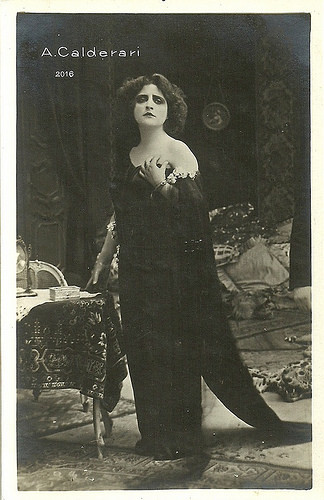
Italian postcard by Ed. G. Vettori, Bologna, no. 2016.
A Silent Italian Western
Dates of the birth and death of Antonietta Calderari lack, but we know she made her film debut in 1911 at the Ambrosio film company of Turin.
She first acted there in a series of short film adaptations of books and plays by Gabriele D'Annunzio: La figlia di Jorio/Jorio's Daughter (1911), La fiaccola sotto il moggio/Blood Vengeance (1911), Sogno di un tramonto d'autunno/An Autumn Sunset Dream (1911), all directed by Luigi Maggi, and La nave/The Ship (Edoardo Bencivenga, 1912). In the latter film she had the lead as the femme fatale Basiliola.
Apart from more shorts at Ambrosio, Calderari also acted in some 17 other shorts by the Turinese company Aquila Films, mostly directed by Roberto Roberti, the father of Sergio Leone. Sometimes Achille Consalvi was the director. These films include Un sogno/A Dream (1912), La contessa Lara/The countess Lara (1912), Gente onesta/Honest People (1913) based on a story by Guy de Maupassant, L'assassina del Ponte S. Martin/The Mystery of St. Martin's Bridge (Roberto Roberti, 1913), La torre d'espiazione/Tower of Terror (Roberto Roberti, 1913), and the silent Western La vampira Indiana/Indian Vampire (Roberto Roberti, 1913).
After a few more films at Ambrosio, Calderari did some 13 more films at Aquila in the years 1916-1917, including La cavalcata dei sogni/The Cavalcade of Dreams (Roberto Roberti, 1917) starring Bice Valerian, the wife of Roberto Roberti and the mother of Sergio Leone.
In the years 1917-1919, Antonietta Calderari appeared in a few films at Savoia Film and other companies. She had a part in Sansone e la ladra di atleti/Samson and the Thief of Athletes (Amedeo Mustacchi, 1919), starring Luciano Albertini , his girlfriend Linda Albertini and then famous cyclist Costante Girardengo as one of the kidnapped cyclists of the film's title. A fragment of this film was found at the Dutch EYE Filmmuseum.
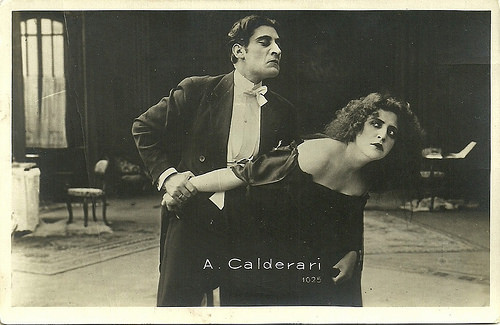
Italian postcard by Ed. A. Vettori, Bologna, no. 1025. Antonietta Calderari in Naufragio (Luigi Mele, 1920) for Albertini-Film. Naufragio was praised in the Italian press, in particular for Calderari's performance. The film about a female sinner, was at the time better known as Calze di seta (Silk Stockings) and meant death for one of the actors, Vittorio Casali. Director Mele was accused of having neglected the danger to which Casali was exposed during a scene, causing Casali to succumb to a state of depression and finally die of cardiac arrest.
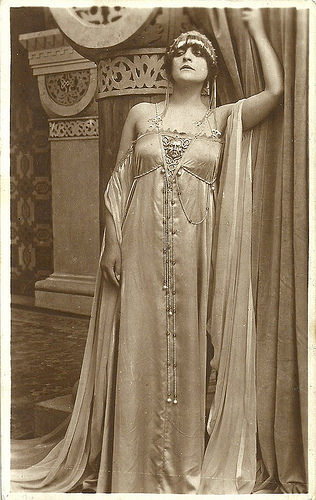
Italian postcard. Photo: Unione Cinematografica Italiana. Antonietta Calderari in Il pontd dei sospiri (Domenico Gaido, 1921). Caption: The most beautiful Imperia, empress of the courtesans.
Wealthy Courtesan
Antonietta Calderari acted in a series opposite strongman Celio Bucchi and directed by Luigi Mele, Lotte nell'aria/Cracked in the air (Luigi Mele, 1920) also with Alfredo Boccolini, Il tempio del sacrificio/The Temple of Sacrifice (1920), and Naufragio/Shipwreck (1921).
Calderari is best remembered for her part of the wealthy courtesan Imperia in the four-part episode-film Il ponte dei sospiri/The Bridge of Sighs (Domenico Gaido, 1921), starring Luciano Albertini .
In the film, she first has an affair on the road with a bandit called Scalabrino, from which a daughter rises. Yet, back in her hometown Venice, the proud Imperia, when rejected by Rolando Candiano ( Luciano Albertini ), son of the Doge, takes revenge by accusing him of a murder she herself committed.
The political enemies of Candiano and his father exploit this to dethrone and blind the Doge and arrest his son on the day of his marriage and throw him in prison, beyond the Bridge of Sighs. But like the Count of Monte Christo, Rolando escapes and takes revenge on his enemies, with the help of Scalabrino (Onorato Garaveo). By doing so he also saves Imperia's daughter from the clutches of one of the conspirators.
The Italian censors not only cut too gruesome scenes of the blinding of the Doge but also erotic images of Imperia undressing and showing her nude behinds.
Antonietta Calderari's last film was Il mistero in casa del dottore/Mystery at the doctor's house (Alessandro De Stefani, 1922) produced by Pasquali Film.
Unknown is what she did afterwards nor when she died. Who knows more?
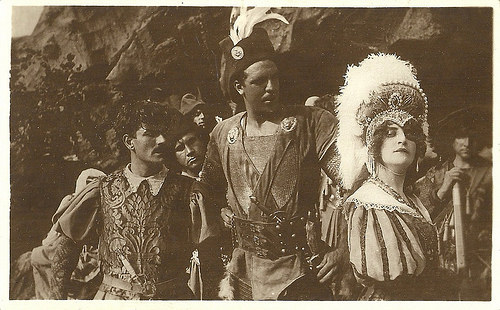
Italian postcard. Photo: Unione Cinematografica Italiana. Photo: Unione Cinematografica Italiana. Publicity still for Il ponte dei sospiri/The Bridge of Sighs (Domenico Gaido, 1921). Caption: Imperia,the most beautiful Roman courtesan, will select the bandit Scalabrino for one night of love, causing the hate and jealousy of Sandrigo.
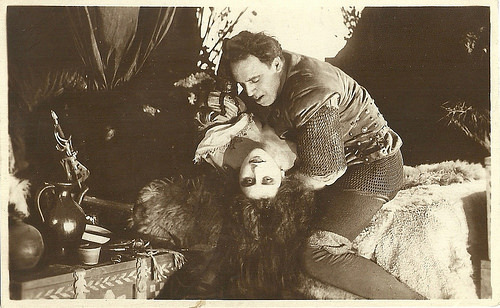
Italian postcard. Photo: Unione Cinematografica Italiana. Photo: Unione Cinematografica Italiana. Publicity still for Il ponte dei sospiri/The Bridge of Sighs (Domenico Gaido, 1921). Caption: In the cave of the bandits Imperia becomes the lover of Scalabrino.
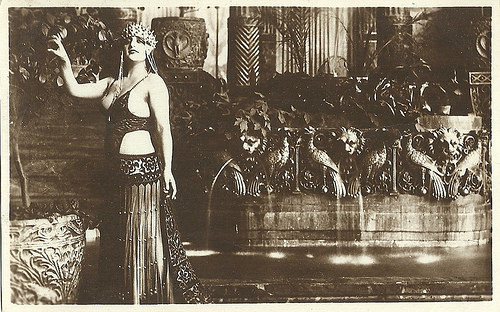
Italian postcard. Photo: Unione Cinematografica Italiana. Photo: Unione Cinematografica Italiana. Publicity still for Il ponte dei sospiri/The Bridge of Sighs (Domenico Gaido, 1921). Caption: Imperia, the empress of the courtesans, is dressed in ball attire, for her famous dances.
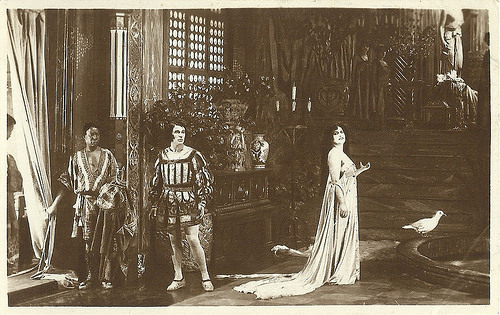
Italian postcard. Photo: Unione Cinematografica Italiana. Photo: Unione Cinematografica Italiana. Publicity still for Il ponte dei sospiri/The Bridge of Sighs (Domenico Gaido, 1921). Caption: Imperia tries to seduce Rolando, but she is rejected, and will vilely take revenge.
Sources: Vittorio Martinelli ( Il cinema muto italiano, 1921-1922 - Italian), Wikipedia and .

Italian postcard by Ed. G. Vettori, Bologna, no. 2016.
A Silent Italian Western
Dates of the birth and death of Antonietta Calderari lack, but we know she made her film debut in 1911 at the Ambrosio film company of Turin.
She first acted there in a series of short film adaptations of books and plays by Gabriele D'Annunzio: La figlia di Jorio/Jorio's Daughter (1911), La fiaccola sotto il moggio/Blood Vengeance (1911), Sogno di un tramonto d'autunno/An Autumn Sunset Dream (1911), all directed by Luigi Maggi, and La nave/The Ship (Edoardo Bencivenga, 1912). In the latter film she had the lead as the femme fatale Basiliola.
Apart from more shorts at Ambrosio, Calderari also acted in some 17 other shorts by the Turinese company Aquila Films, mostly directed by Roberto Roberti, the father of Sergio Leone. Sometimes Achille Consalvi was the director. These films include Un sogno/A Dream (1912), La contessa Lara/The countess Lara (1912), Gente onesta/Honest People (1913) based on a story by Guy de Maupassant, L'assassina del Ponte S. Martin/The Mystery of St. Martin's Bridge (Roberto Roberti, 1913), La torre d'espiazione/Tower of Terror (Roberto Roberti, 1913), and the silent Western La vampira Indiana/Indian Vampire (Roberto Roberti, 1913).
After a few more films at Ambrosio, Calderari did some 13 more films at Aquila in the years 1916-1917, including La cavalcata dei sogni/The Cavalcade of Dreams (Roberto Roberti, 1917) starring Bice Valerian, the wife of Roberto Roberti and the mother of Sergio Leone.
In the years 1917-1919, Antonietta Calderari appeared in a few films at Savoia Film and other companies. She had a part in Sansone e la ladra di atleti/Samson and the Thief of Athletes (Amedeo Mustacchi, 1919), starring Luciano Albertini , his girlfriend Linda Albertini and then famous cyclist Costante Girardengo as one of the kidnapped cyclists of the film's title. A fragment of this film was found at the Dutch EYE Filmmuseum.

Italian postcard by Ed. A. Vettori, Bologna, no. 1025. Antonietta Calderari in Naufragio (Luigi Mele, 1920) for Albertini-Film. Naufragio was praised in the Italian press, in particular for Calderari's performance. The film about a female sinner, was at the time better known as Calze di seta (Silk Stockings) and meant death for one of the actors, Vittorio Casali. Director Mele was accused of having neglected the danger to which Casali was exposed during a scene, causing Casali to succumb to a state of depression and finally die of cardiac arrest.

Italian postcard. Photo: Unione Cinematografica Italiana. Antonietta Calderari in Il pontd dei sospiri (Domenico Gaido, 1921). Caption: The most beautiful Imperia, empress of the courtesans.
Wealthy Courtesan
Antonietta Calderari acted in a series opposite strongman Celio Bucchi and directed by Luigi Mele, Lotte nell'aria/Cracked in the air (Luigi Mele, 1920) also with Alfredo Boccolini, Il tempio del sacrificio/The Temple of Sacrifice (1920), and Naufragio/Shipwreck (1921).
Calderari is best remembered for her part of the wealthy courtesan Imperia in the four-part episode-film Il ponte dei sospiri/The Bridge of Sighs (Domenico Gaido, 1921), starring Luciano Albertini .
In the film, she first has an affair on the road with a bandit called Scalabrino, from which a daughter rises. Yet, back in her hometown Venice, the proud Imperia, when rejected by Rolando Candiano ( Luciano Albertini ), son of the Doge, takes revenge by accusing him of a murder she herself committed.
The political enemies of Candiano and his father exploit this to dethrone and blind the Doge and arrest his son on the day of his marriage and throw him in prison, beyond the Bridge of Sighs. But like the Count of Monte Christo, Rolando escapes and takes revenge on his enemies, with the help of Scalabrino (Onorato Garaveo). By doing so he also saves Imperia's daughter from the clutches of one of the conspirators.
The Italian censors not only cut too gruesome scenes of the blinding of the Doge but also erotic images of Imperia undressing and showing her nude behinds.
Antonietta Calderari's last film was Il mistero in casa del dottore/Mystery at the doctor's house (Alessandro De Stefani, 1922) produced by Pasquali Film.
Unknown is what she did afterwards nor when she died. Who knows more?

Italian postcard. Photo: Unione Cinematografica Italiana. Photo: Unione Cinematografica Italiana. Publicity still for Il ponte dei sospiri/The Bridge of Sighs (Domenico Gaido, 1921). Caption: Imperia,the most beautiful Roman courtesan, will select the bandit Scalabrino for one night of love, causing the hate and jealousy of Sandrigo.

Italian postcard. Photo: Unione Cinematografica Italiana. Photo: Unione Cinematografica Italiana. Publicity still for Il ponte dei sospiri/The Bridge of Sighs (Domenico Gaido, 1921). Caption: In the cave of the bandits Imperia becomes the lover of Scalabrino.

Italian postcard. Photo: Unione Cinematografica Italiana. Photo: Unione Cinematografica Italiana. Publicity still for Il ponte dei sospiri/The Bridge of Sighs (Domenico Gaido, 1921). Caption: Imperia, the empress of the courtesans, is dressed in ball attire, for her famous dances.

Italian postcard. Photo: Unione Cinematografica Italiana. Photo: Unione Cinematografica Italiana. Publicity still for Il ponte dei sospiri/The Bridge of Sighs (Domenico Gaido, 1921). Caption: Imperia tries to seduce Rolando, but she is rejected, and will vilely take revenge.
Sources: Vittorio Martinelli ( Il cinema muto italiano, 1921-1922 - Italian), Wikipedia and .
Published on December 01, 2017 22:00
Paul van Yperen's Blog
- Paul van Yperen's profile
- 13 followers
Paul van Yperen isn't a Goodreads Author
(yet),
but they
do have a blog,
so here are some recent posts imported from
their feed.



